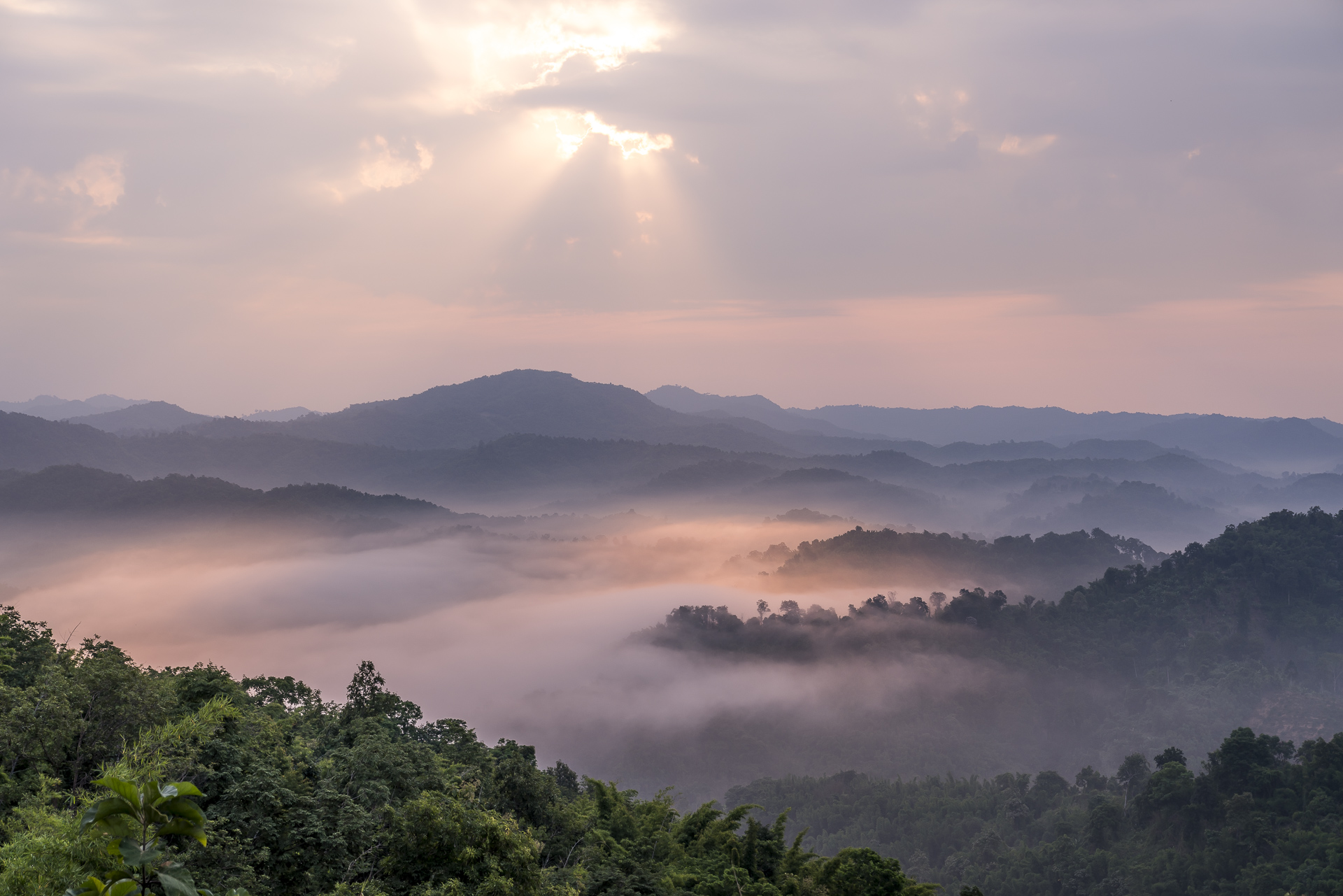
Northern Thailand Trip: Our Highlights Between Chiang Rai and Sukhothai
Northern Thailand Tour: Route Overview
The program for our 9-day trip to Northern Thailand was put together by Local Alike. As a regionally anchored tour operator, Local Alike consistently focuses on the integration of local communities (community-based tourism) and is committed to fair and sustainable tourism.
Our journey started at the northernmost tip of Thailand – the so-called “Golden Triangle”. From there we traveled south via Chiang Rai and Chiang Mai to the smallest province of northern Thailand, “Lamphun”. Afterwards we continued south to the provincial capital Lampang. And finally, we explored the hinterland as well as the historical sites of the first great Thai kingdom Sukhothai.
All the highlights mentioned in the text, and also all our accommodations and other recommended discoveries along the way, are located in the following map.
We made this trip with a private driver as well as a tour guide. Driver Golf and guide Nemo were the perfect travel companion for this tour. Thanks in part to both of them, this trip will be remembered for a long time! At this point «khop khun kah» dear Nemo and dear golf.
Northern Thailand can also be explored individually by train, bus and shared taxis (or with your own rental car). Due to the language barrier, contact and exchange with the local population is difficult without Thai knowledge – especially outside the cities of Chiang Mai and Chiang Rai.
Start of the journey in the very north of Thailand at the mystical Golden Triangle
The journey from Switzerland to northern Thailand takes us with Thai Airways via Bangkok to Chiang Rai. From there it is a good hour’s drive to the village of Ban Sop Ruak, which is located at the confluence of the Ruak and Mekong rivers in the so-called Golden Triangle between Thailand, Laos and Myanmar. A beautiful overview of the border triangle is offered by the viewpoint at the Golden Triangle Park.
It was not so long ago that the farmers here earned their money mainly with the cultivation of opium poppies and thus with the production of opium or heroin and drug trafficking. In the Golden Triangle Park Hall of Opium, the historical background as well as the measures taken against the opium trade are well presented. Today, the cultivation of opium poppies is illegal in Thailand – instead, attempts are being made to boost tourism in the area to provide alternative sources of income for the local population.
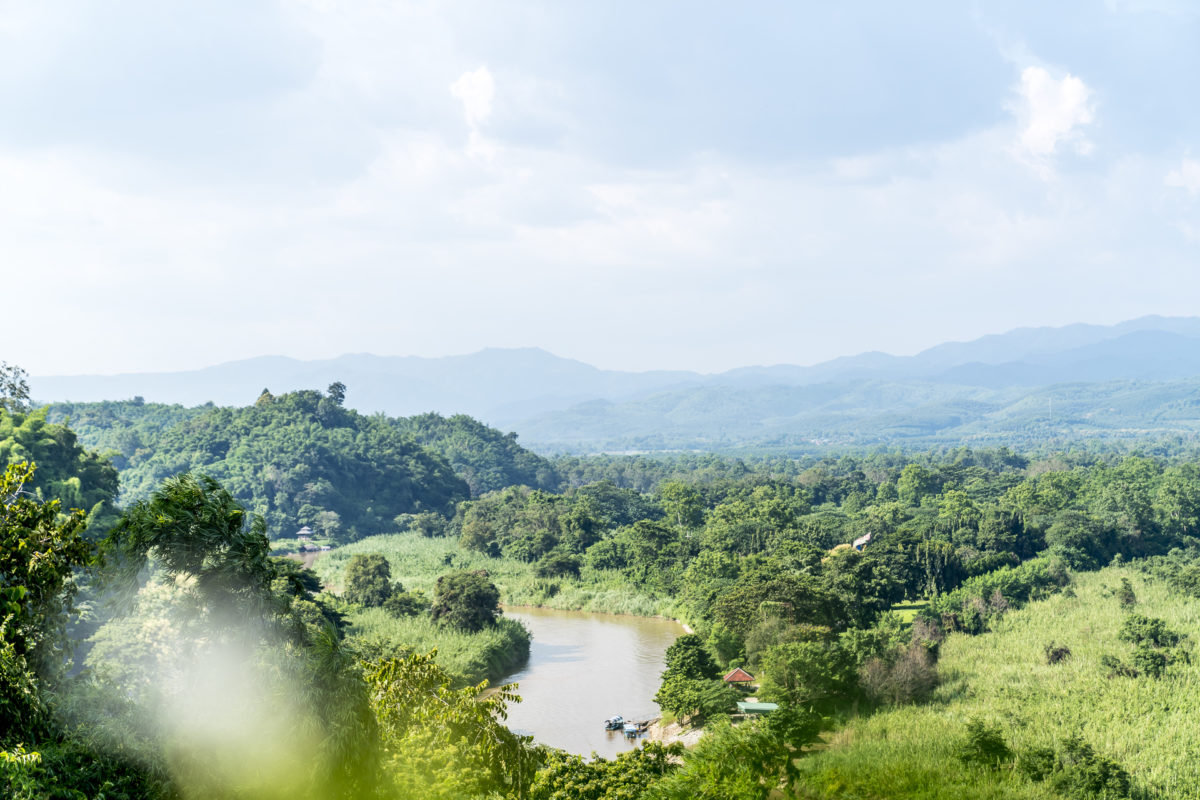
While on the Laotian shore, chunky casino resorts vie for Thai visitors (gambling is illegal in Thailand), there are some hidden, exquisite accommodations on the Thai side. They are perfect to arrive after a long journey or to round off a trip to northern Thailand with the necessary portion of relaxation. For us, the former is the order of the day and for this we are allowed to check in for one night at the Anantara Golden Triangle Elephant Camp & Resort, which is beautifully embedded in the landscape directly opposite the Hall of Opium.
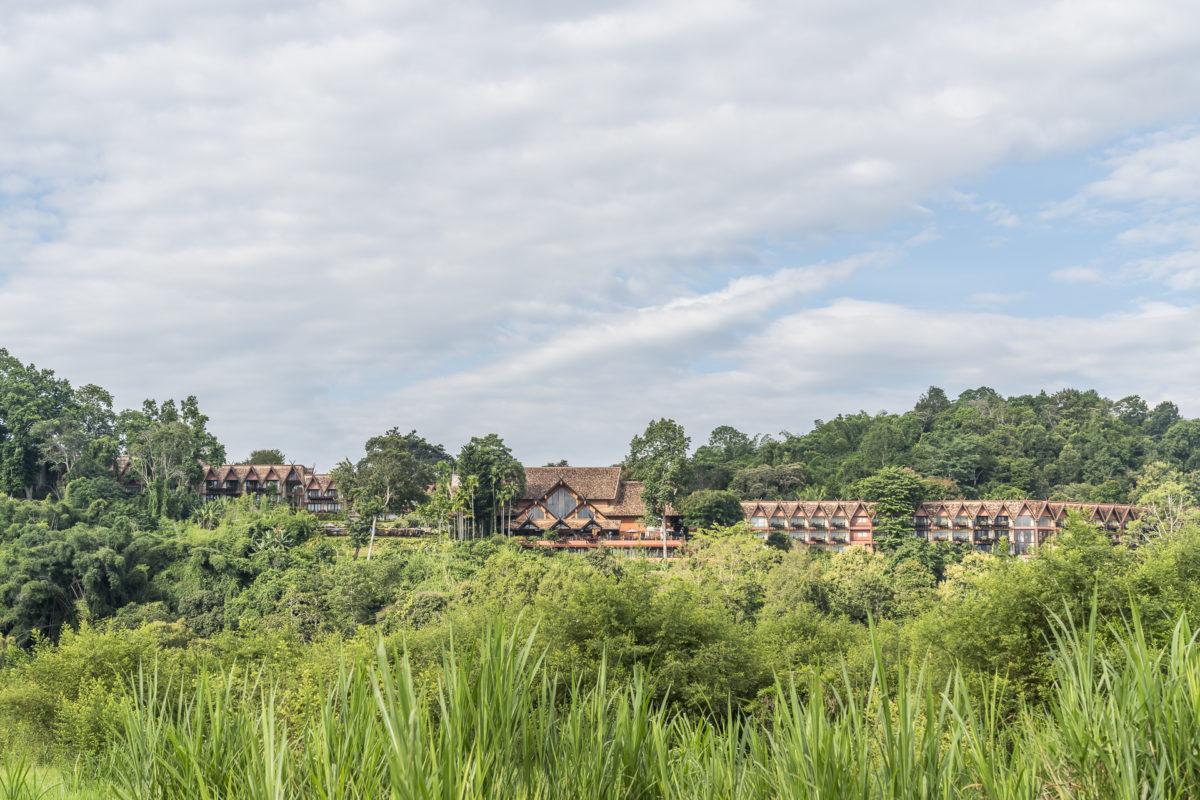
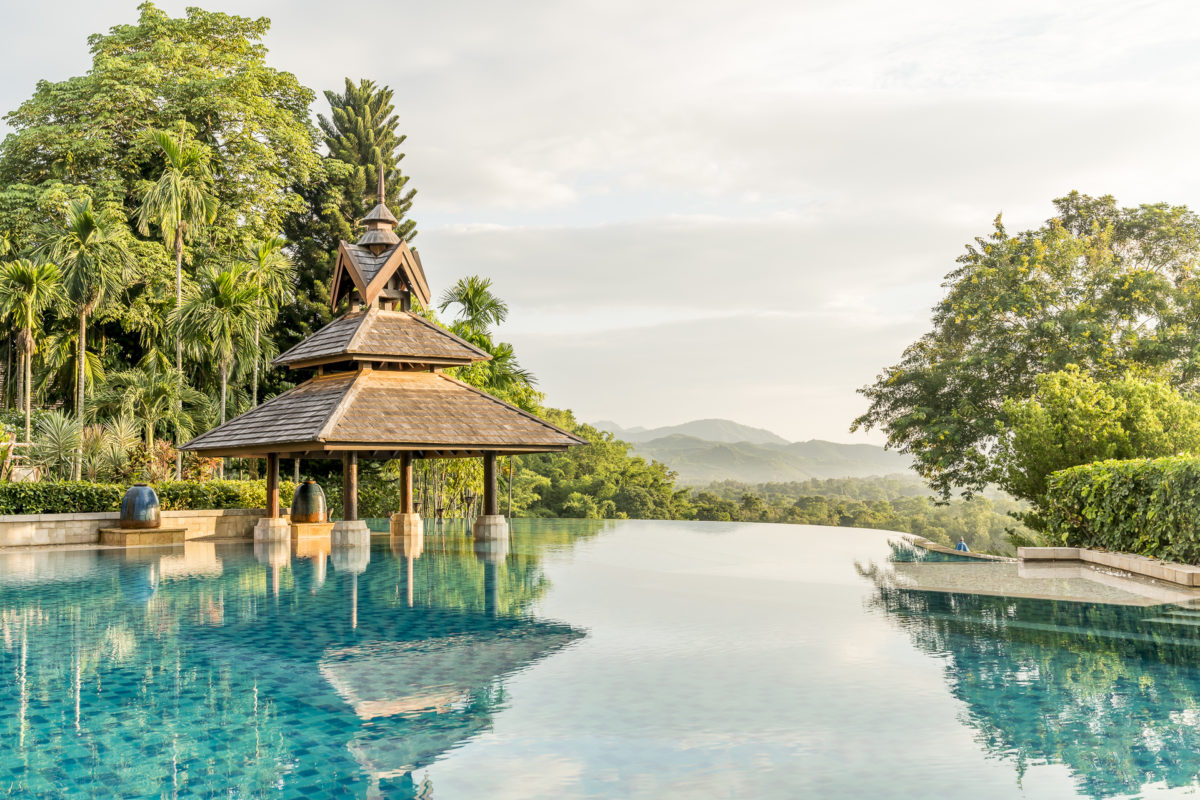
The hotel not only boasts an infinity pool with a view over the green canopy to the Mekong River, but also offers a new home to elephants, which were mainly rescued from illegal logging camps or elephant shows. The topic of elephants (and especially elephant riding) is controversial in northern Thailand and is a difficult topic per se.
I think it’s great that Local Alike, as a tour operator, is against supporting offers that include elephant rides. The next morning, elephant guide Nissa tells us why camps like the one in Anantara are needed and what challenges exist in the interaction between elephant: people and tourism during a walk with the two sympathetic elephant ladies, Lanna and Yui and the bull Mae Moo. We already took part in a recommendable “Walking with Giants” experience in Botswana in spring, and I think the one in Anantara is also worth participating for anyone who wants to get a comprehensive picture of the topic.
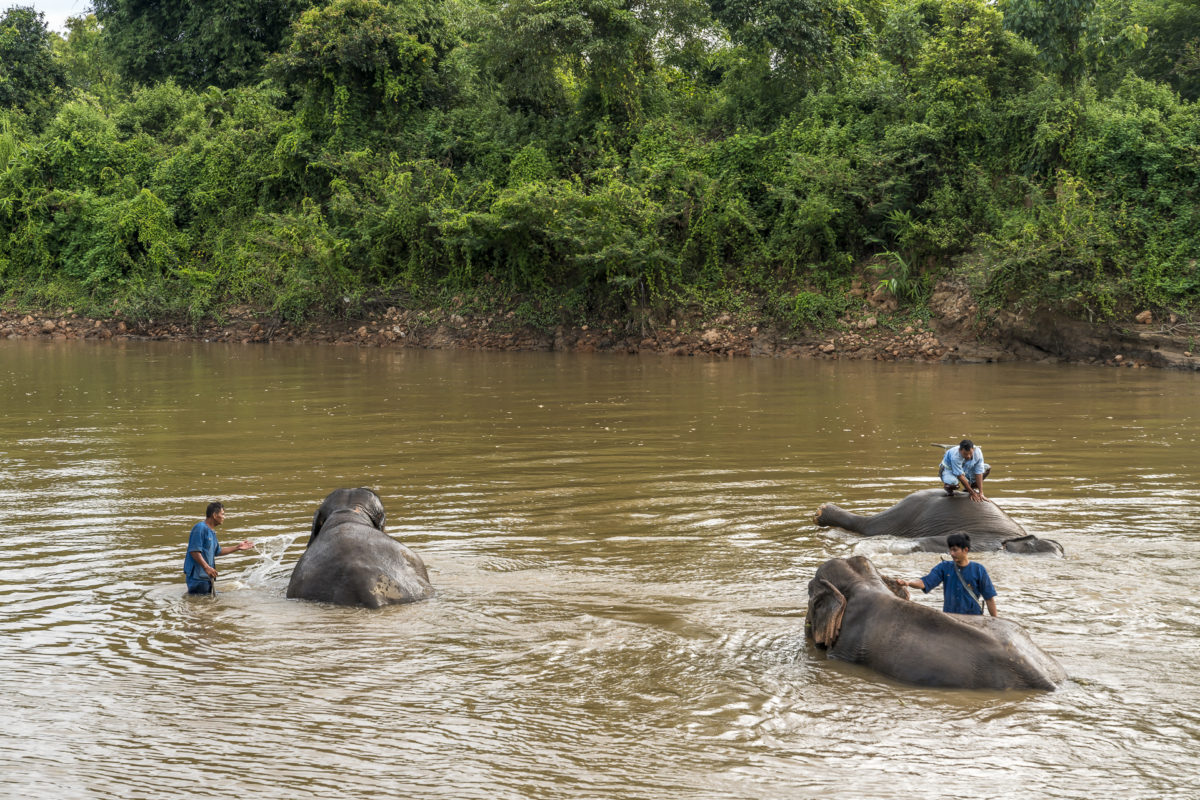
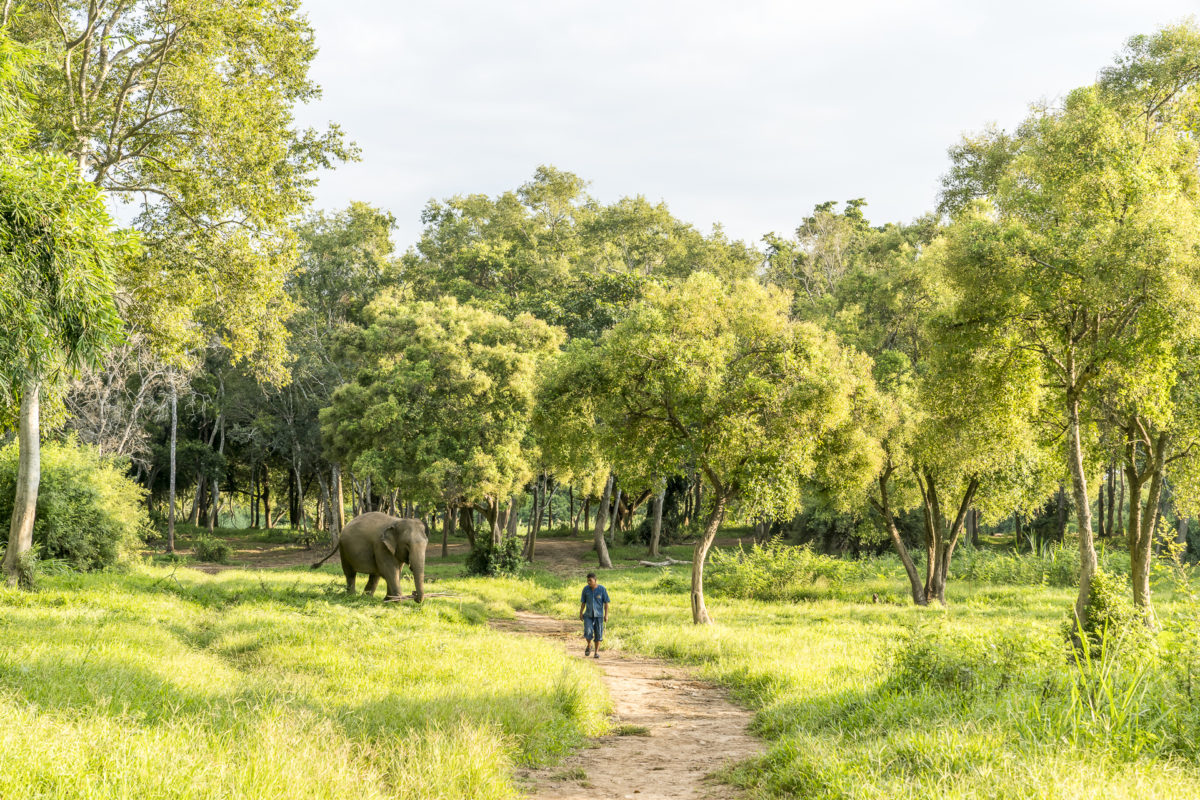
Creative Journeys to the First: Detour to Baan Pang Ha Village
But the Golden Triangle is much more than a collection of luxury accommodations with photogenic infinity pools, as we discover the next day. Today we go to the village of Pang Ha, about 15 kilometers upstream. Lately, the Thai Tourism Authority has consistently supported the development of community-based creative tourism. And so there are some village communities in northern Thailand, which provide an insight into local rural life and traditional crafts through various activities. This is also the case with Pang Ha – here we learn how to make beautifully grained paper from the bark of the paper mulberry tree.
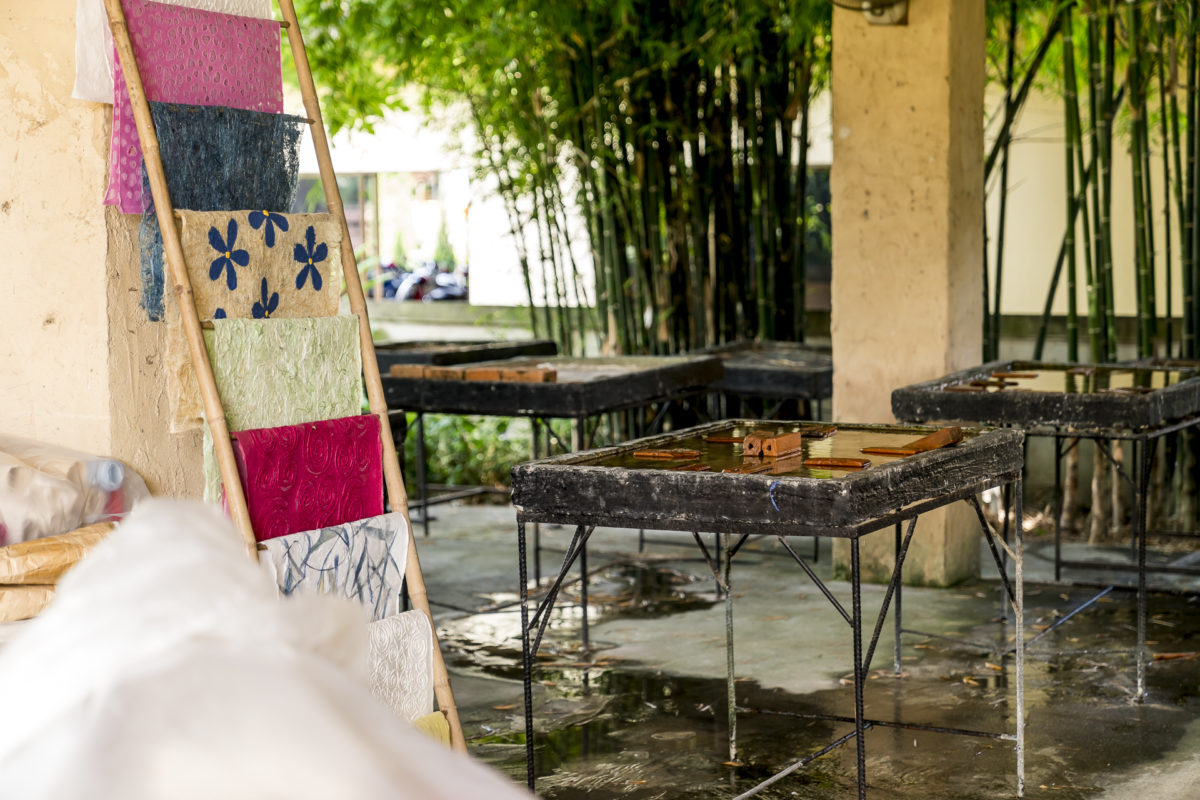
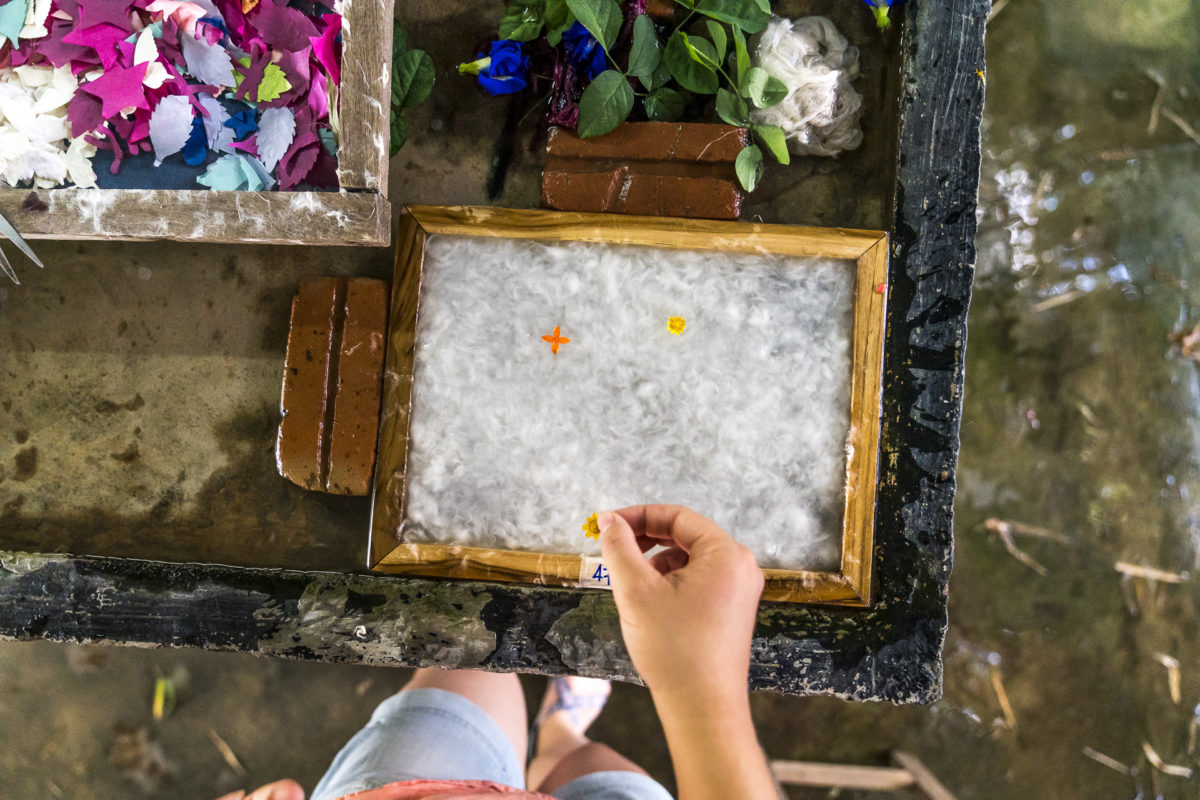
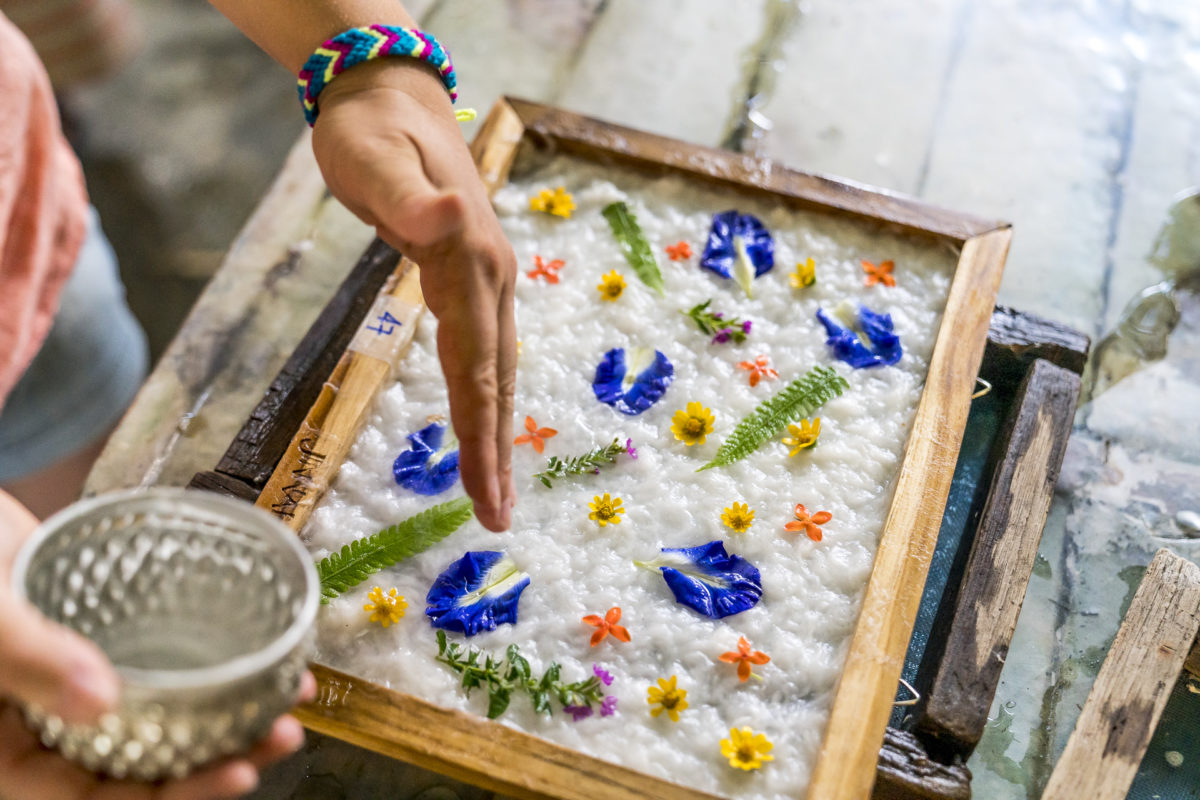
Later, I get to try the Ceilk Gold Mask, which is made in the village. At the same time, I am amazed at how such a small village can bring such a high-quality cosmetics line to the market. Despite numerous awards, however, it is still difficult for the village community to place its products internationally. They are all the more happy about our visit – to my astonishment, there are only a handful of other guests on site that afternoon – most of them Thais.
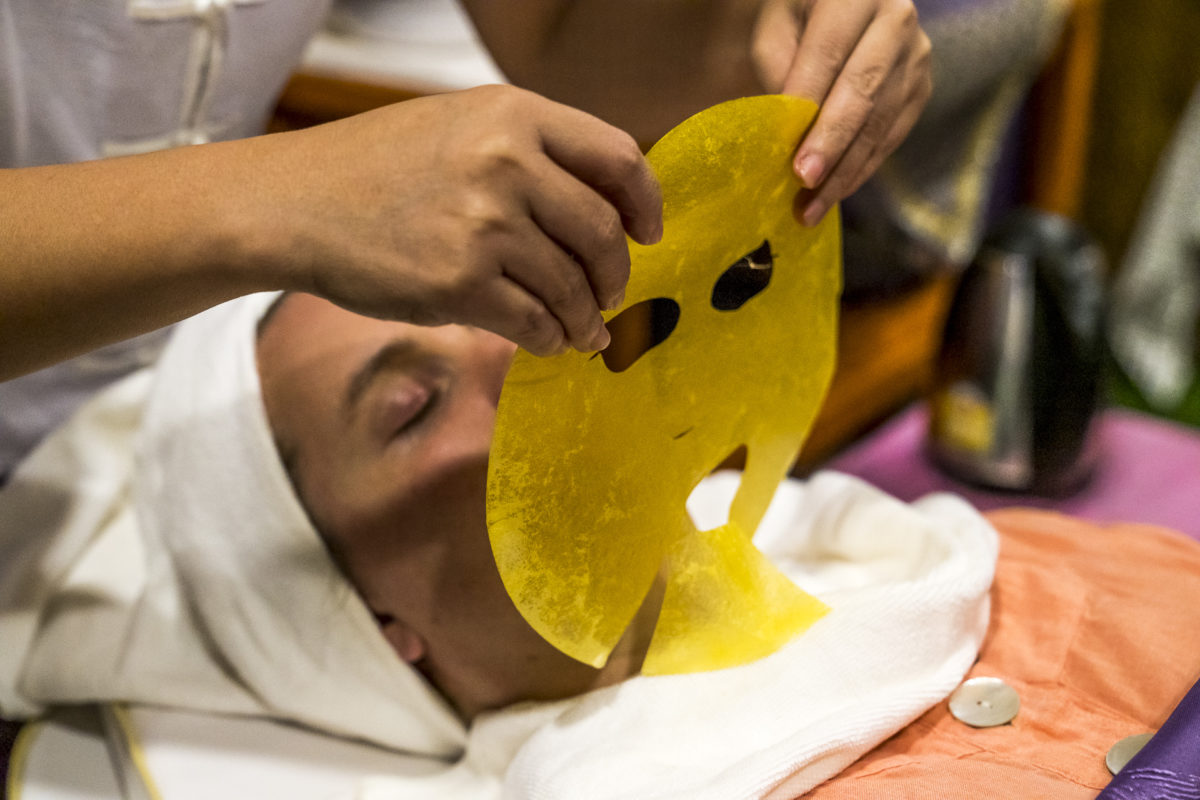
My initial fear that we would be confronted with masses of tourists and “loveless” check-in during these village visits vanishes into thin air here. I care about the appreciation and consideration of the privacy of village communities, and I have a lot of trouble with voyeuristic “exploitation”. I find it all the more remarkable how in Pang Ha (and also in the other communities we will visit this week) the focus is clearly on creative activities and exchange with the local population.
There are also some lovely homestays in the village. These include the Auykham – which offers spacious rooms with private bathrooms for the equivalent of around 15 – 17 CHF per night. The daughter of the owners has decided against a big-city life in Bangkok and is now supporting her parents in the expansion of the guesthouse and the associated restaurant (where they eat very fine, by the way!).
Contemplative and hustle and bustle around Chiang Rai
From Pang Ha we then return to Chiang Rai via Khun Nam Nang Non Forest Park. This forest reserve is home to the Tham Luang Karst Caves, which received worldwide media attention due to the spectacular rescue operation of twelve trapped children in 2018. In the short term, this led to a veritable rush of visitors – primarily Thais. Meanwhile, the popularity is already flattening out again. During our visit, many of the souvenir stalls seem referencing. A nice stopover – for me, the walk through the secluded tropical mixed forest awakens the desire to discover more of these green-covered hills in the border area of Thailand/Myanmar.
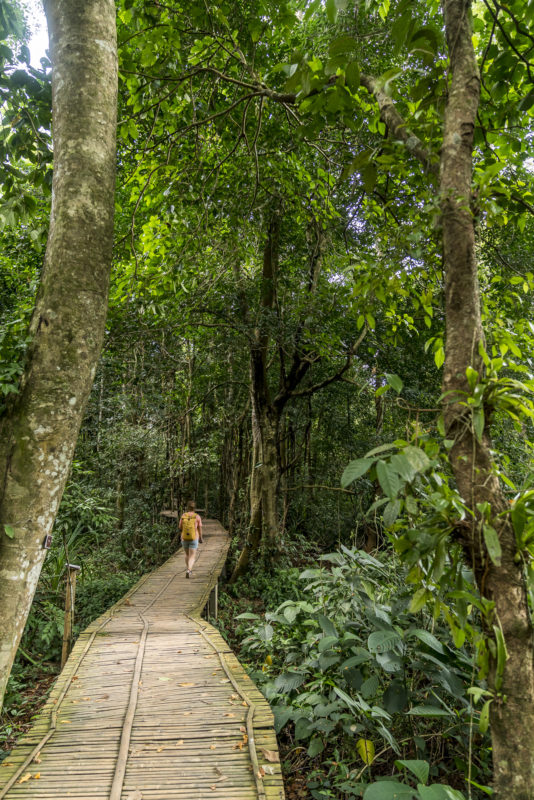
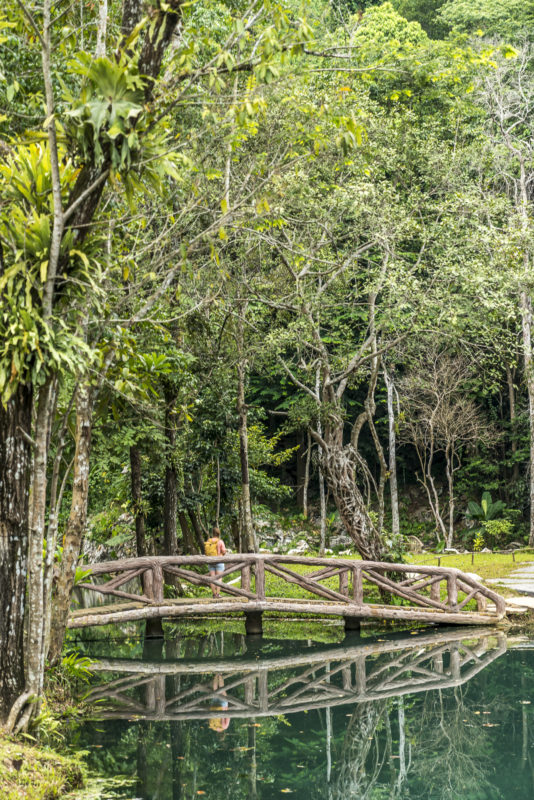
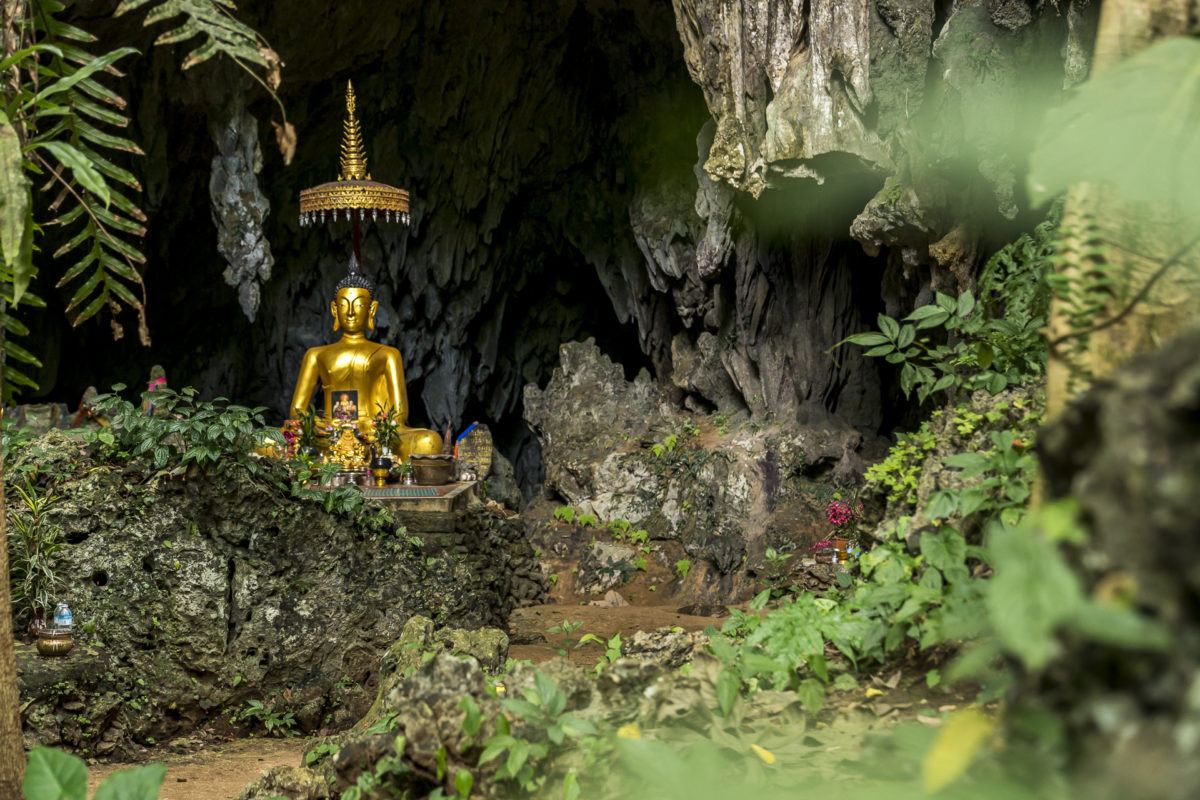
Back in Chiang Rai, there’s a funny surprise when you check in at The Legend. General Manager Peter Schnyder is not only Swiss, but was in the same secondary school class as my father. After all, the world is a village.
Built in the traditional Lanna style for the region, The Legend is located on the banks of the Mae Nam Kok River and offers an idyllic base from which to explore Thailand’s northernmost provincial capital. If you’re in Chiang Rai on Sunday like we are, you shouldn’t miss the Sunday Night Market. Every Sunday evening, San Khong Noi Road is transformed into a pedestrian street, where one food stall follows the next. But you can not only taste all the exotic dishes here, but also mingle with the dancing Thais on the neighborhood square. On the way there, it is worth stopping at Wat Phra Kaew – here, according to legend, Thailand’s national sanctuary – the Emerald Buddha – was found.
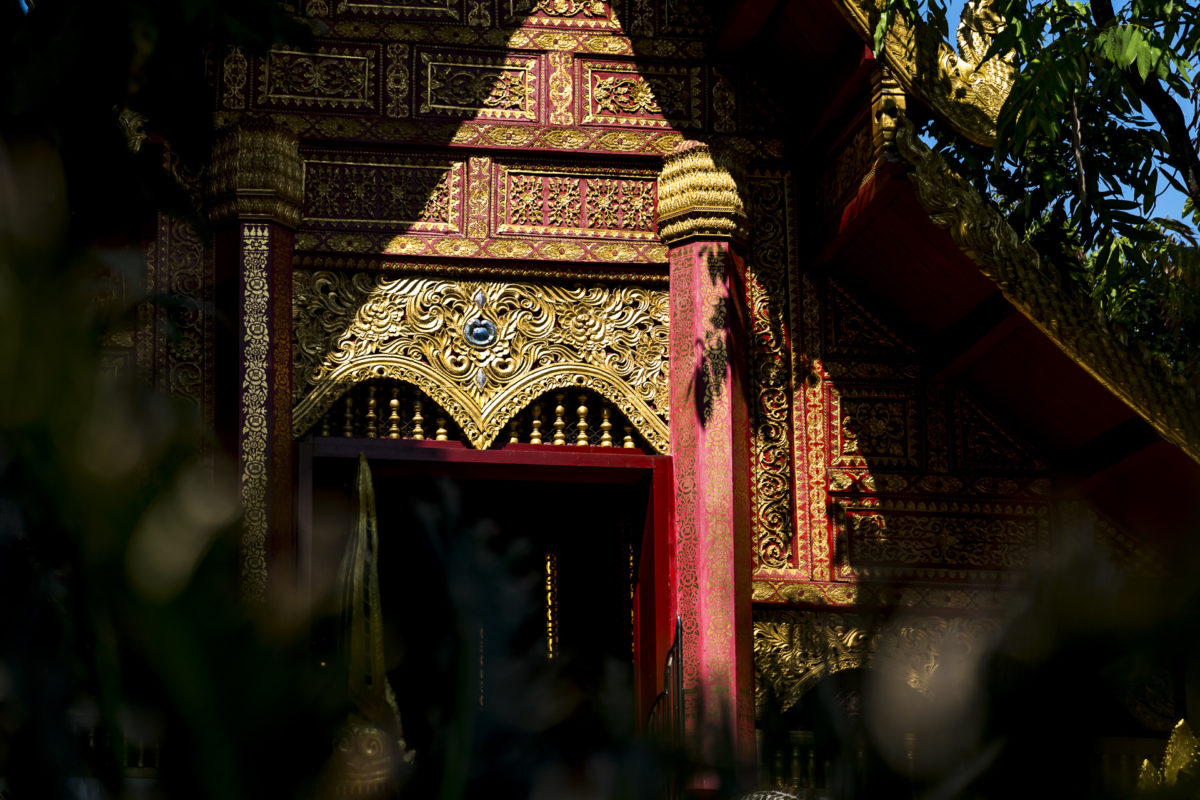
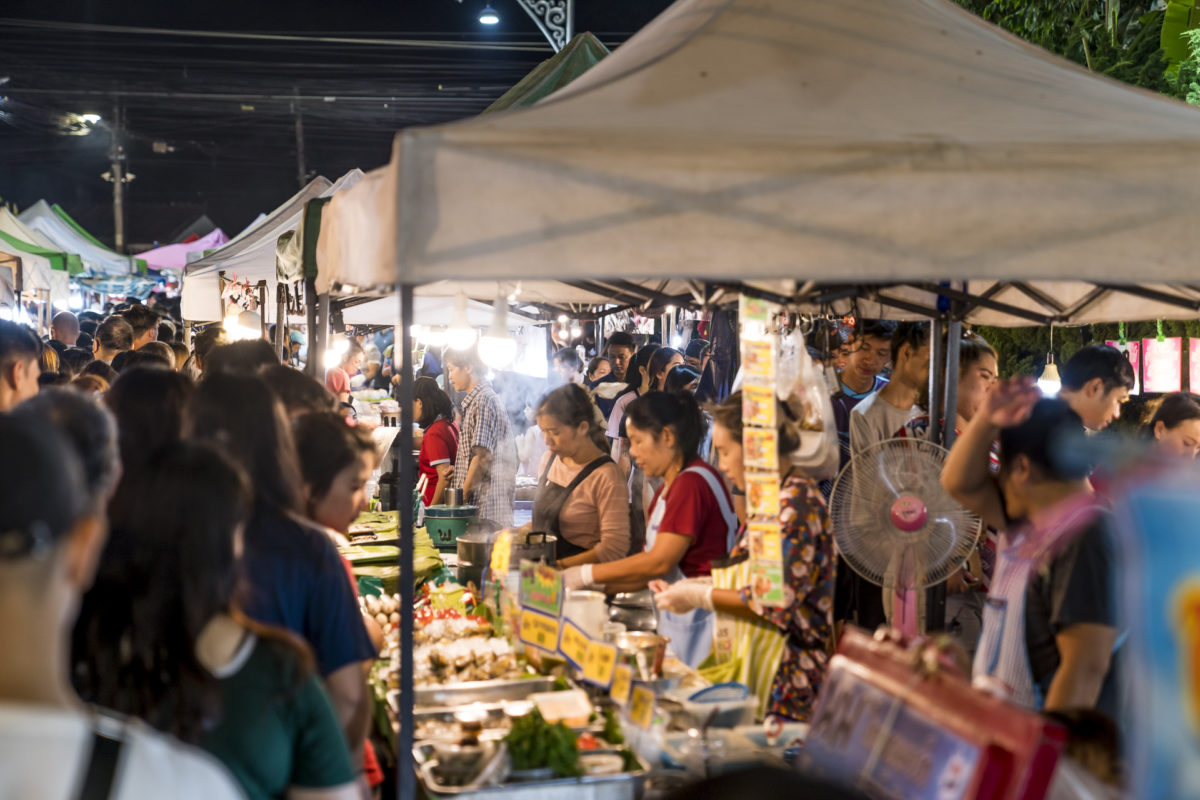
While I am astonished to discover that we are the only foreign tourists on site at both the Sunday Night Market and Wat Phra Kaew, I am taught better the next morning at Wat Rong Khun. It is teeming with Chinese guests, who pose in every conceivable way in front of the famous White Temple (which is not a temple in the classical sense, but is actually a private art collection/art installation built in the style of a Buddhist temple complex). However, the crowds are not unexpected – Wat Rong Khun is one of Chiang Rai’s top sights.
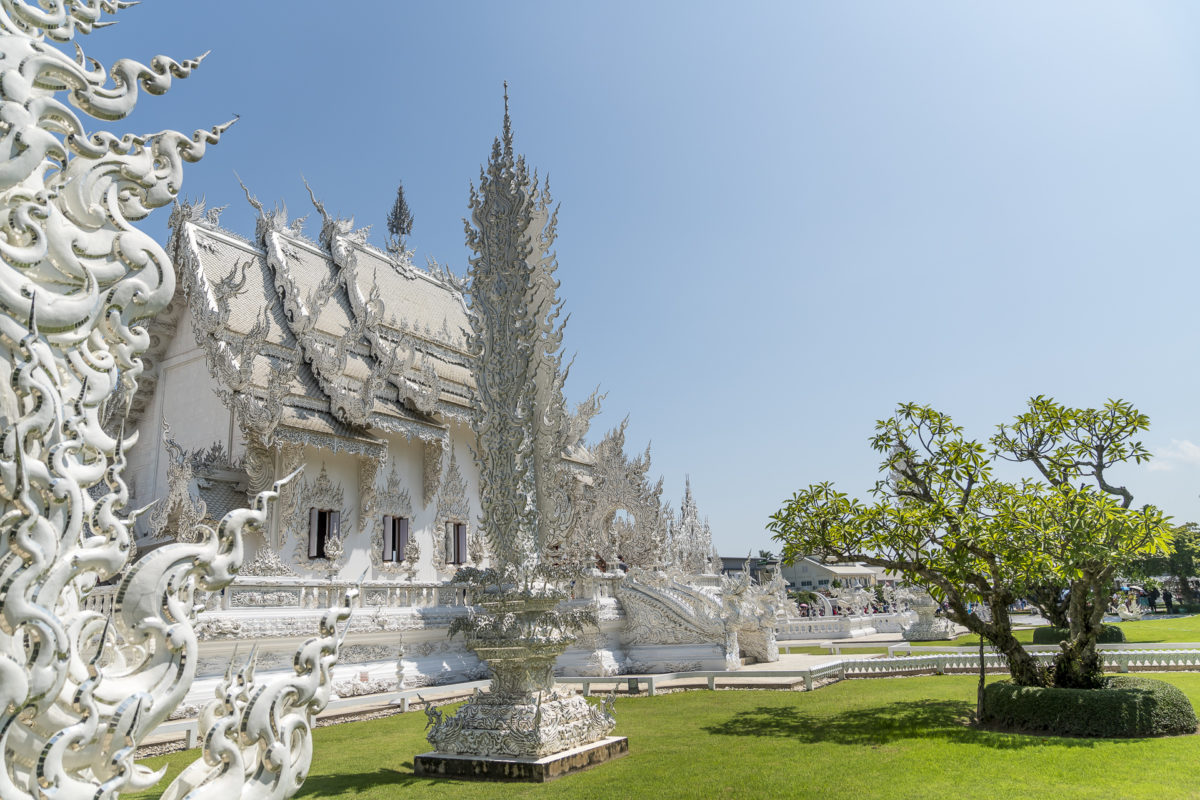
Best of Tempelhopping in Chiang Mai
To visit all the markets and temples of Chiang Rai, an overnight stay on site is definitely too short. But our next destination – Chiang Mai – also has plenty of temples to offer. With over 300 temples, there are more temples per inhabitant and square kilometer than anywhere else in Thailand. Something is almost lost in the fact that Chiang Mai also scores with an original old town surrounded by a wall and moat. The rectangular city center is clearly visible on maps.
I have seen countless reports, pictures, and impressions of Chiang Mai in the last few years and had my ideas of what the city will be like. The reality was different. Better. Authentic. And once again I realized: There are almost no foreign tourists!
Of the many temples that can be visited in Chiang Mai, the first one we visited was Wat Phra That Doi Suthep. It is located on a hill east of the city and is particularly atmospheric in the evening light. Shortly after dark, we are back in the old town and treat ourselves to a traditional Thai massage at the Zira Spa before dinner at the casual The House by Ginger. On Nemo’s advice, I put my cross at “soft” and am truly grateful for her tip. The young masseuse stretches and stretches my body parts with full-body effort – how it would feel if I had dared to push harder…
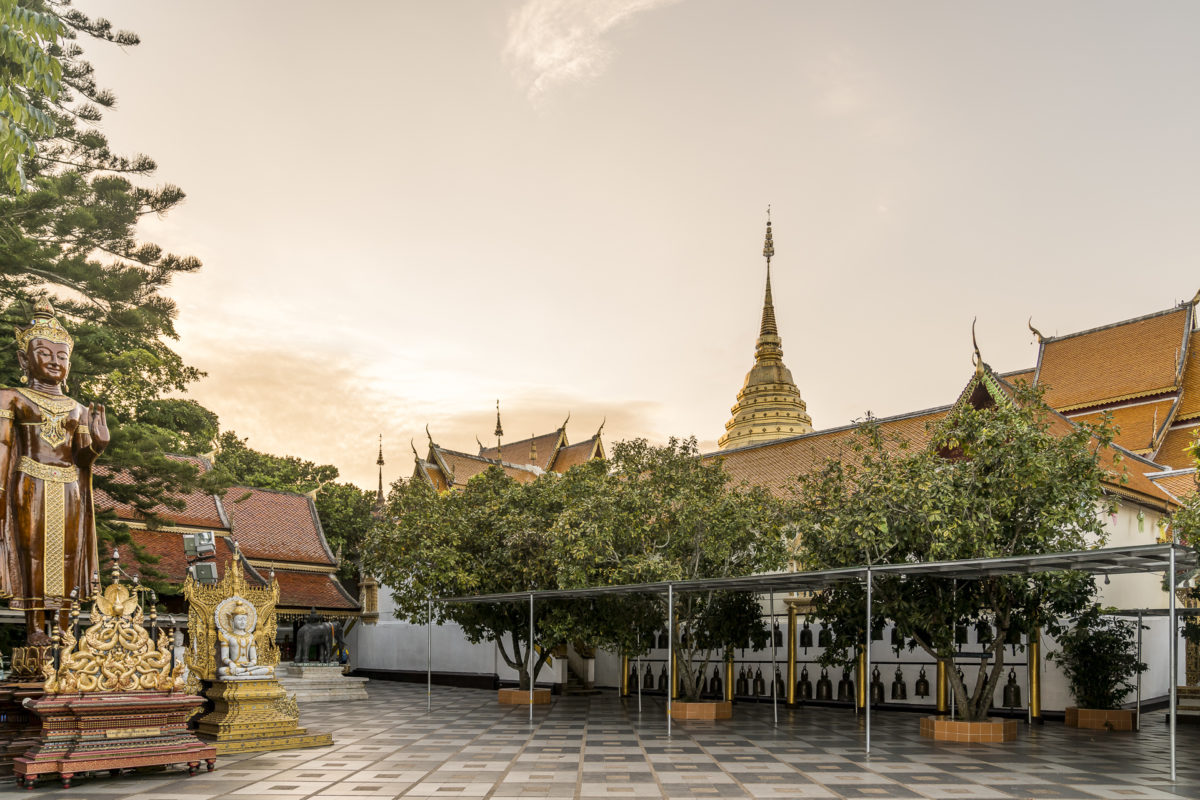
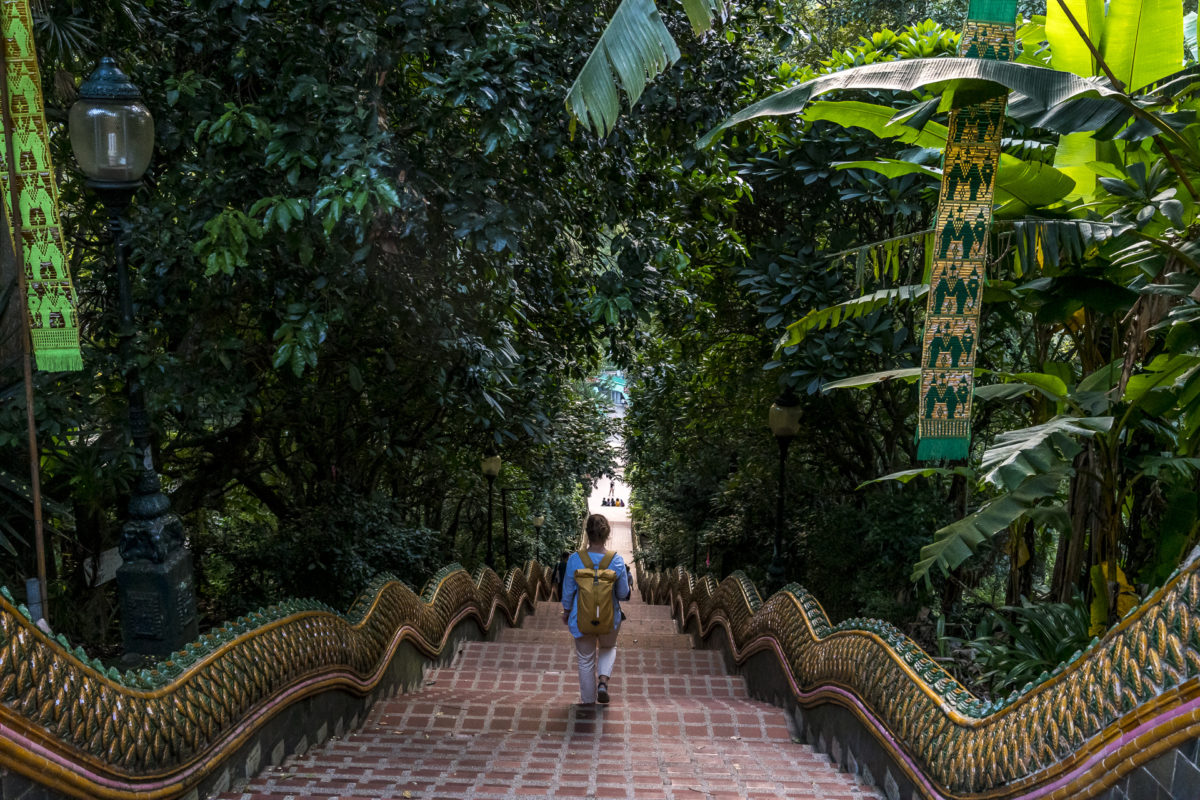
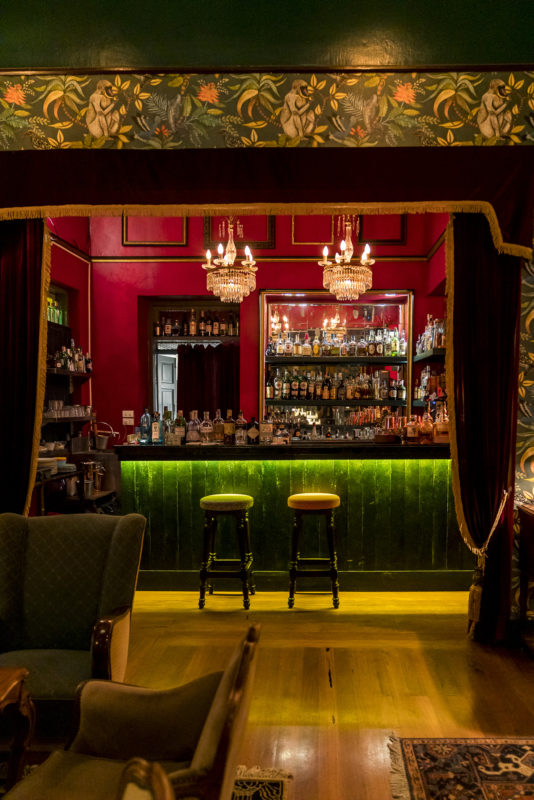
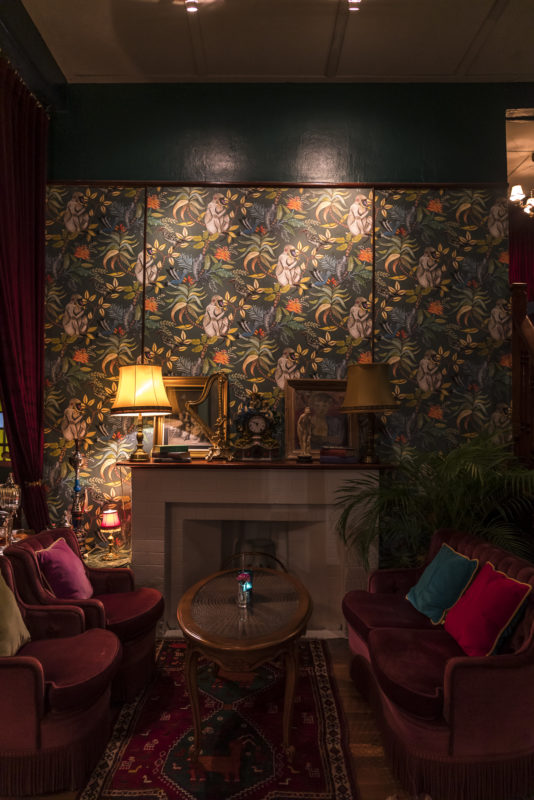
The next morning, the massage makes itself felt with sore muscles. This vanishes during the morning walk through the old town center of Chiang Mai. We let ourselves drift along the Samlarn Road across the city center and visit three temple complexes that are located along the way: the somewhat hidden Wat Phuak Hong with a beautiful chedi overgrown with plants, the magnificent golden shining Wat Phra Singh and the Wat Lok Mo Li as one of the oldest buildings in the city.
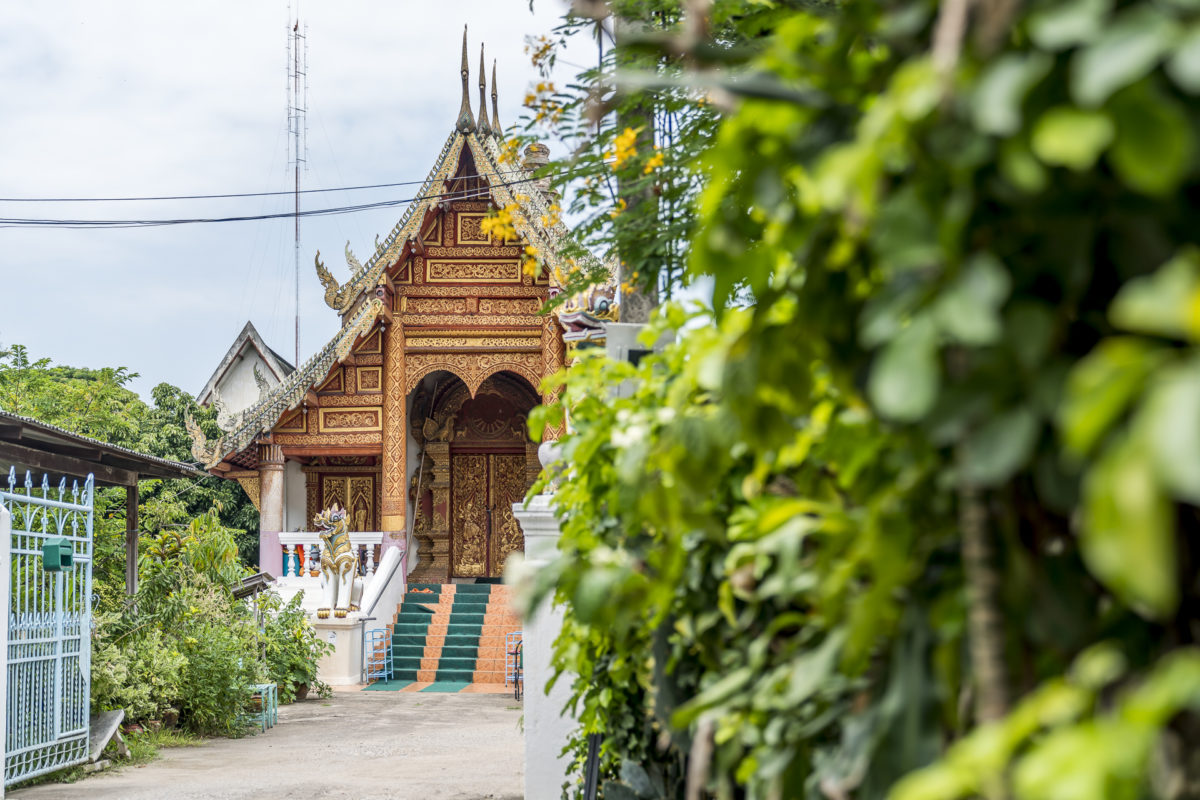
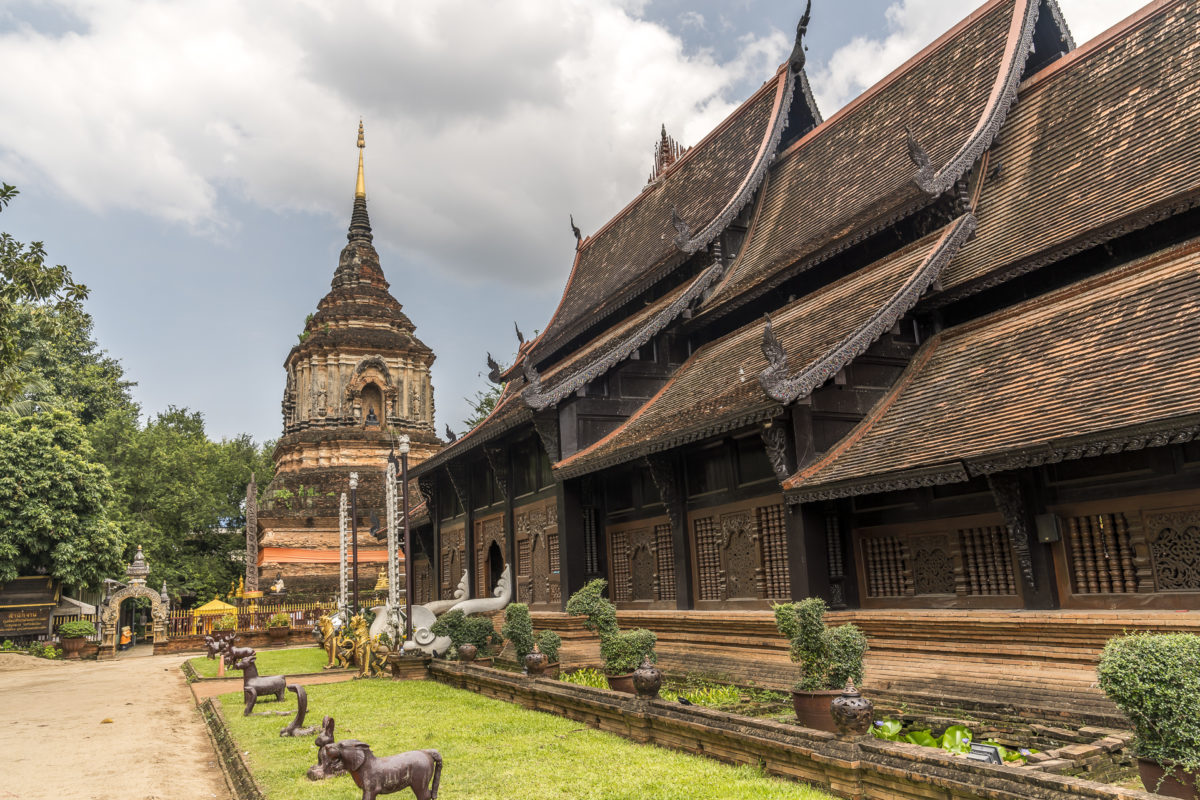
Afterward we also visit Wat Sri Suphan – also known as the “Silver Temple”. The temple is completely covered both on the outside and inside with a finely worked silver plain, with the visit of the interior being reserved for men. The elaborately designed ornaments are made in the workshops around the temple. The artists like to let you look over their shoulders as they work. In addition, there is the opportunity to try out the traditional handicrafts yourself in an entertaining workshop (cost around 200 Baht per person).
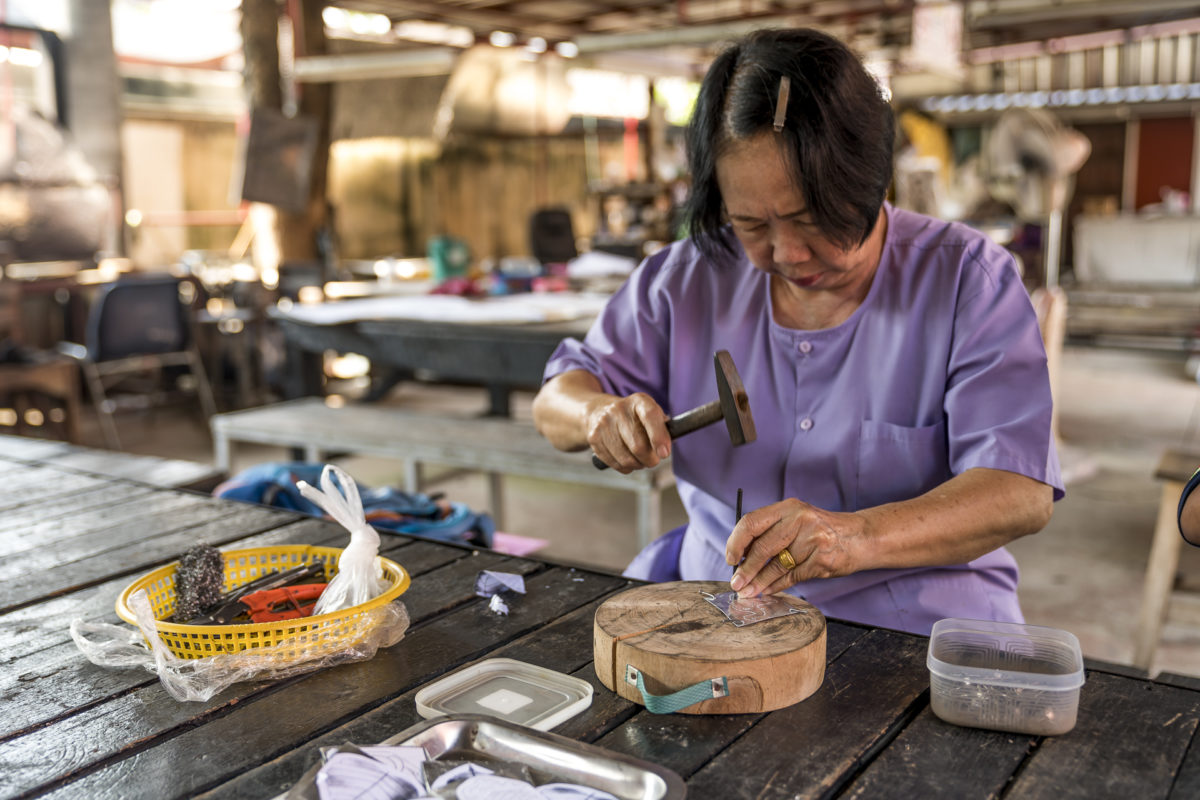
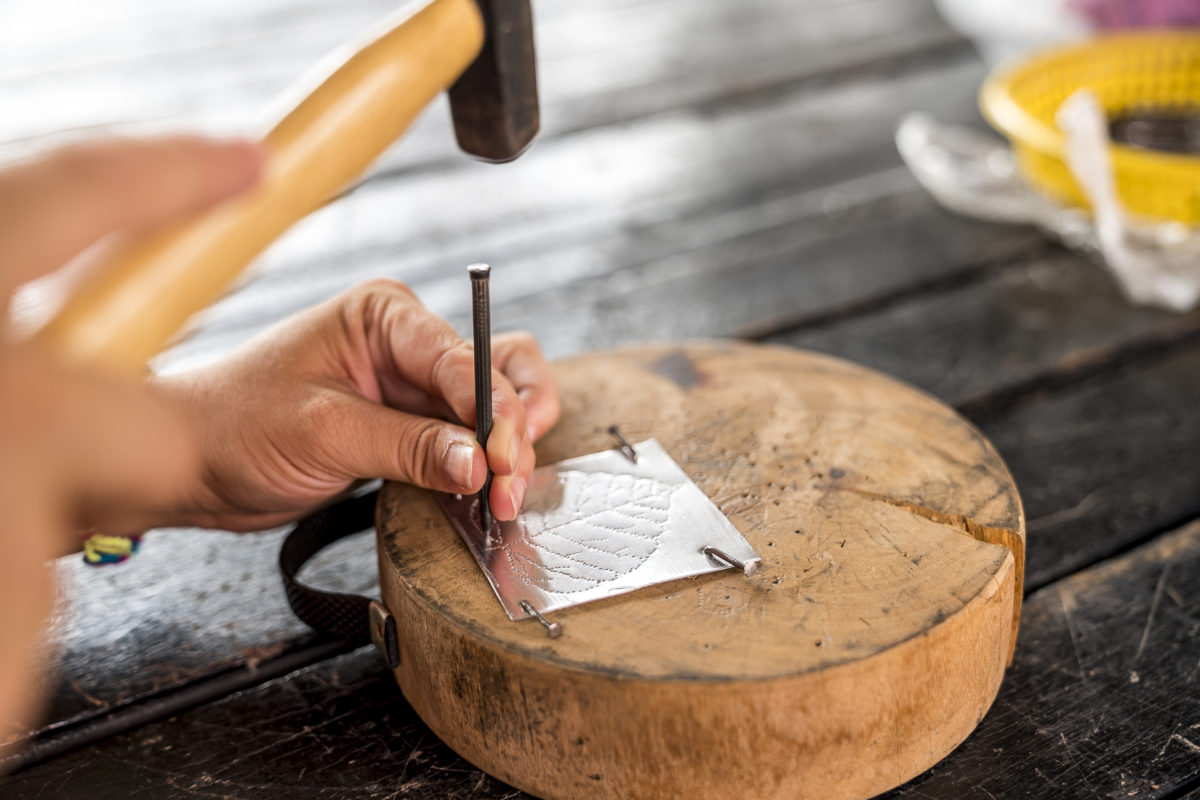
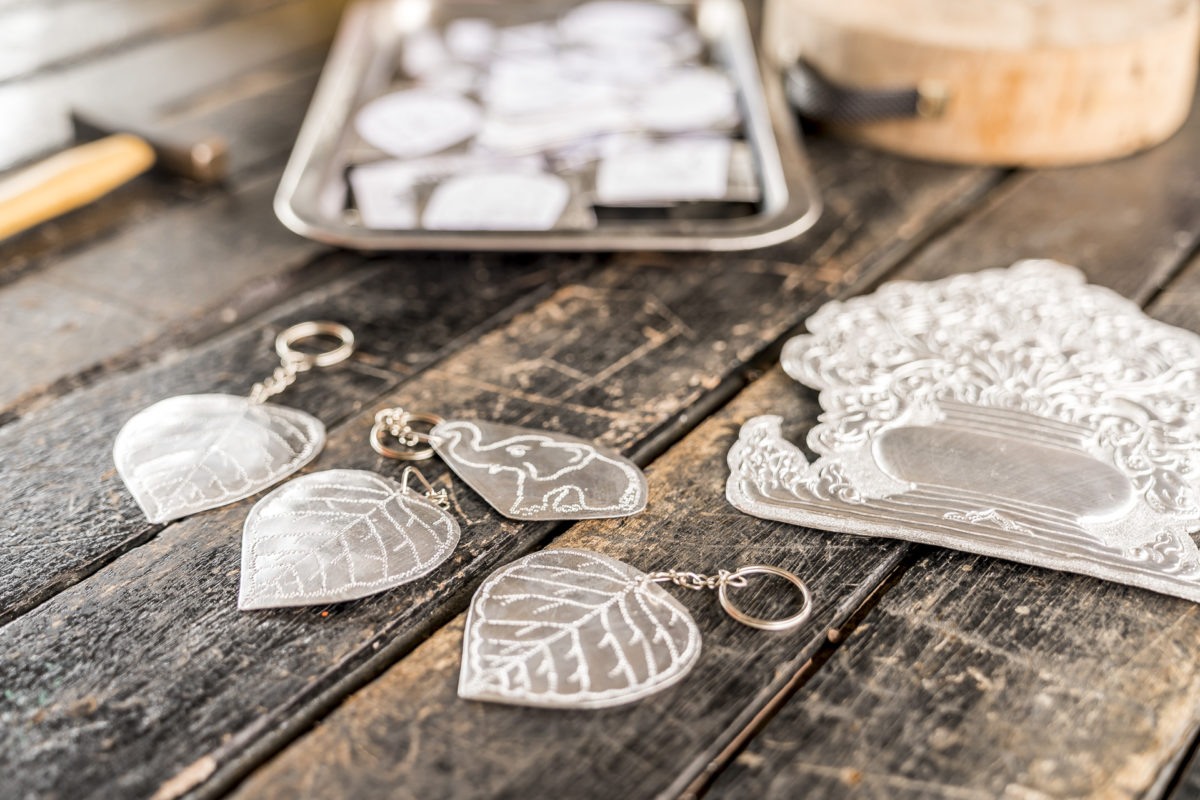
An afternoon full of Thai warmth
After proving our craftsmanship in the silver workshop, we head for the Khao Soi Samerjai restaurant for a quick lunch. Among other things, they serve one of the most typical dishes of northern Thailand: coconut curry soup with wheat noodles and chicken. Just the way I like it.
Afterward we drive to the village of Ban Luang Nuea, about 20 kilometers to the northeast. On Google Maps, the learning center of the local Tai Lue community is only recorded in Thai (ศูนย์การเรียนรู้ภูมิปัญญาไทยไตลื้อ บ้านใบบุญ). The Tai Lue are one of the many tribes of northern Thailand who proudly carry their cultural past to the outside world and pass it on. In this village, too, guests have the opportunity to take part in numerous activities and thus gain an insight into village life and traditional crafts. The warmth and commitment of the villagers involved in the project left a lasting impression on me and touched me immensely!
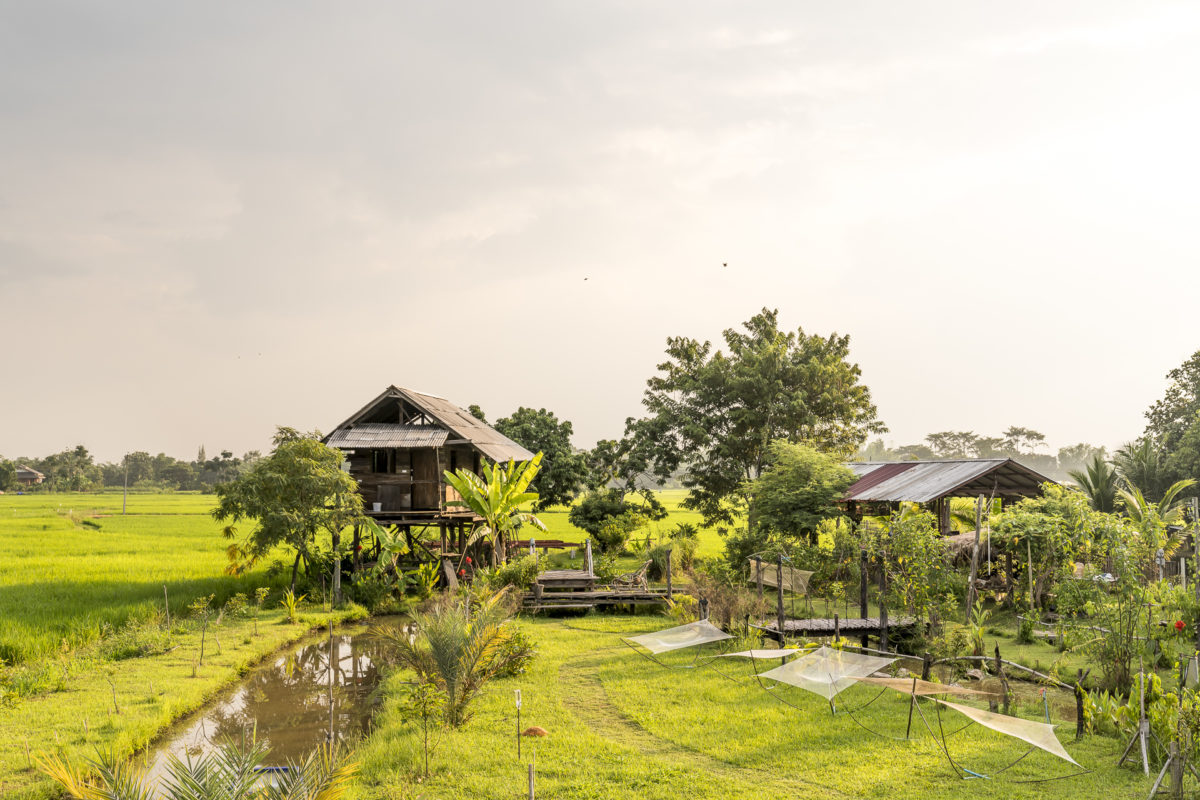
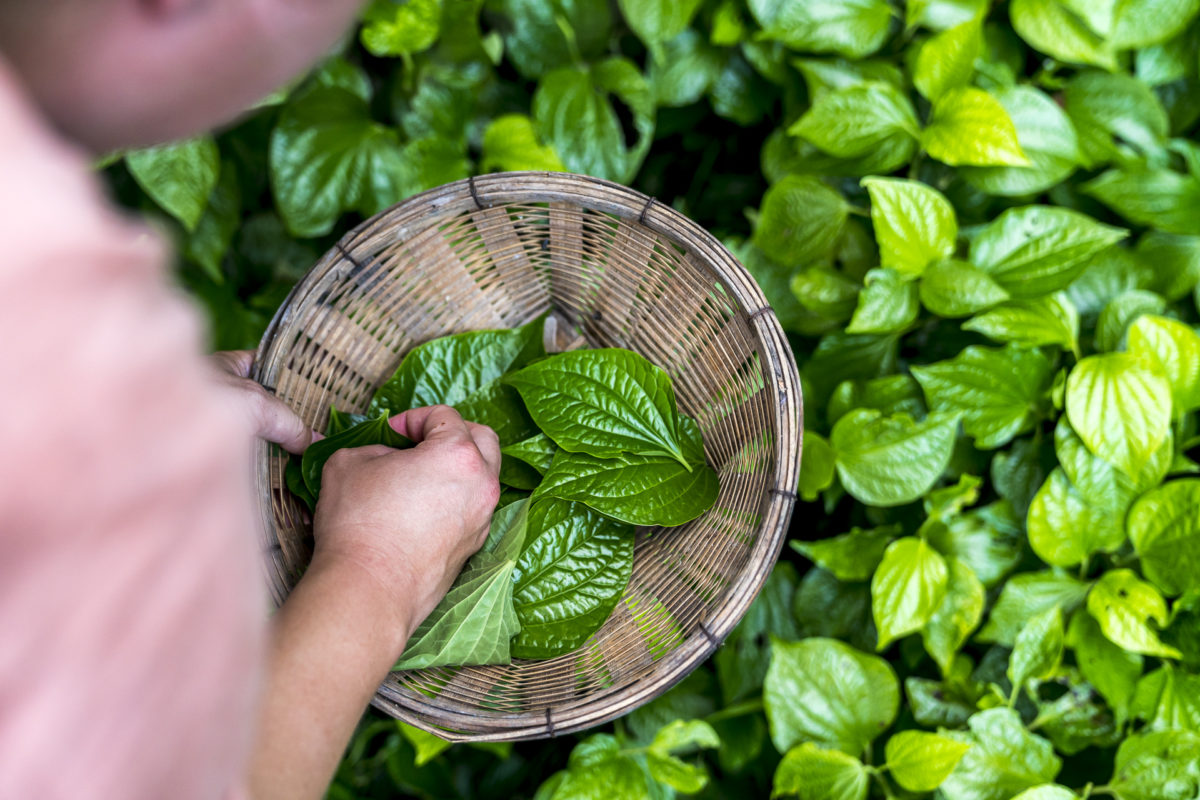
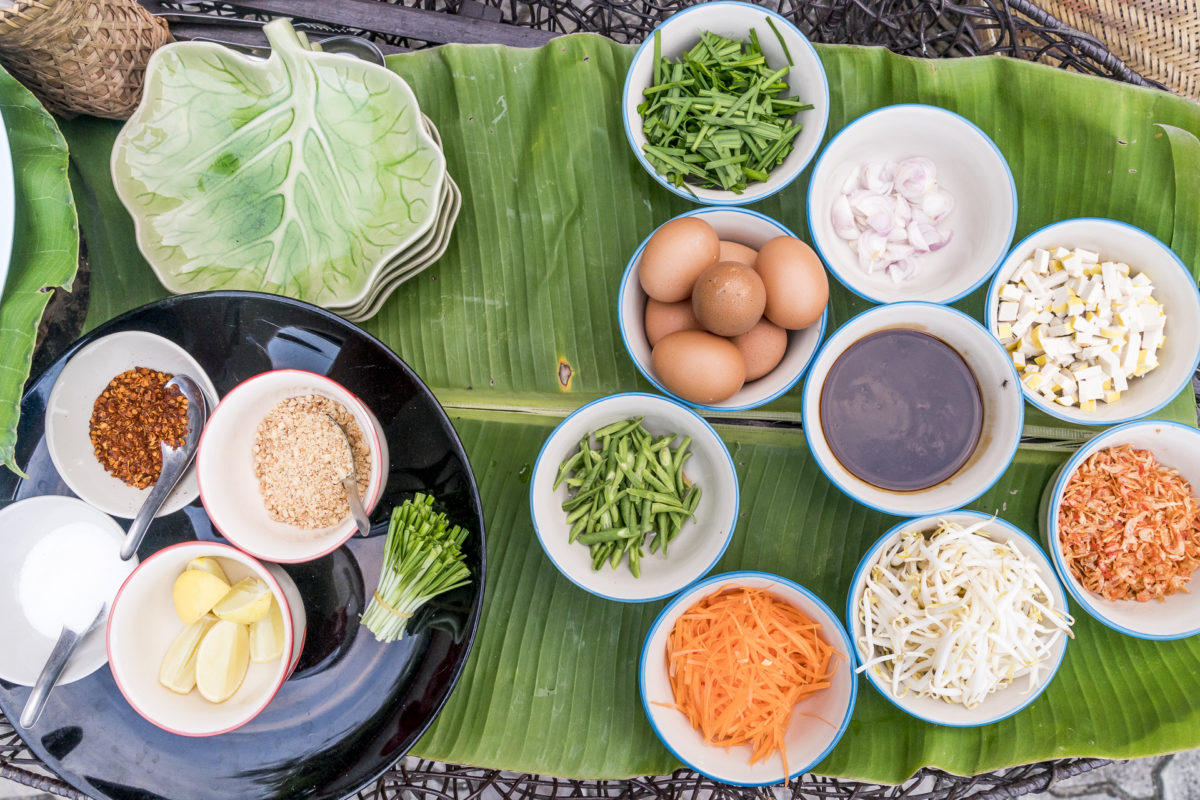
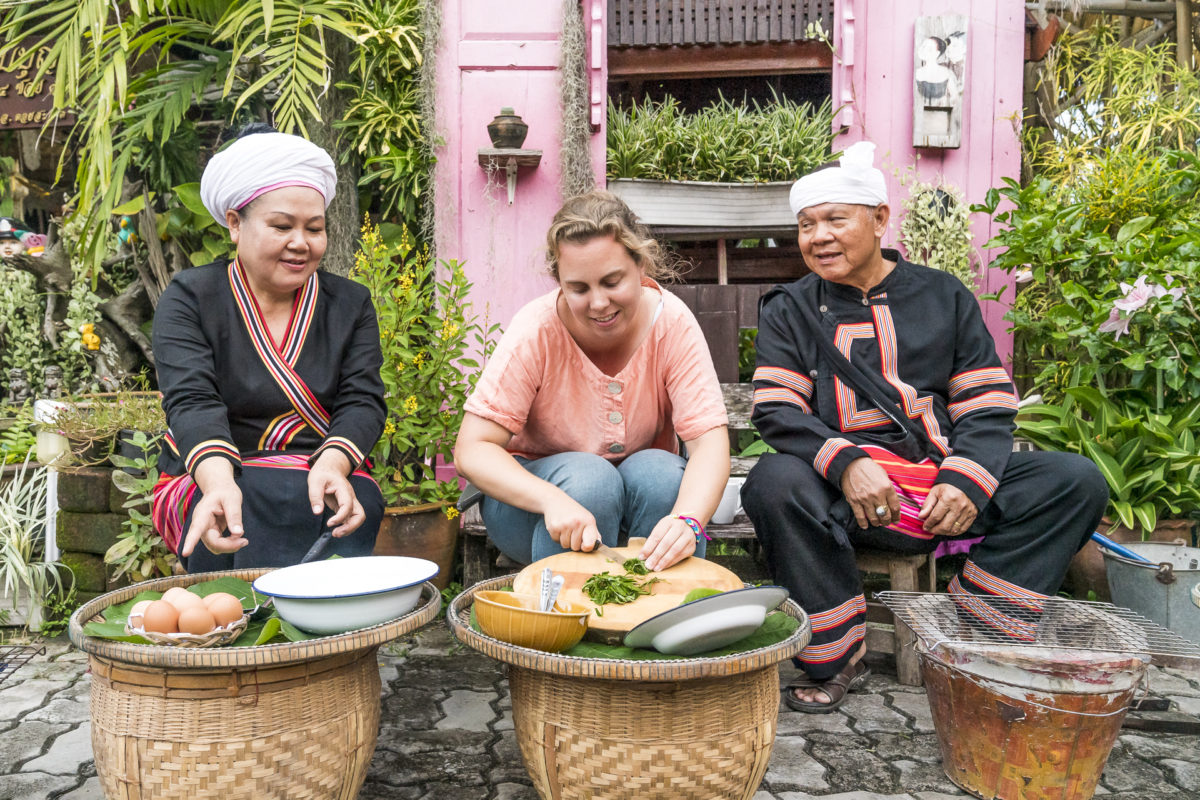
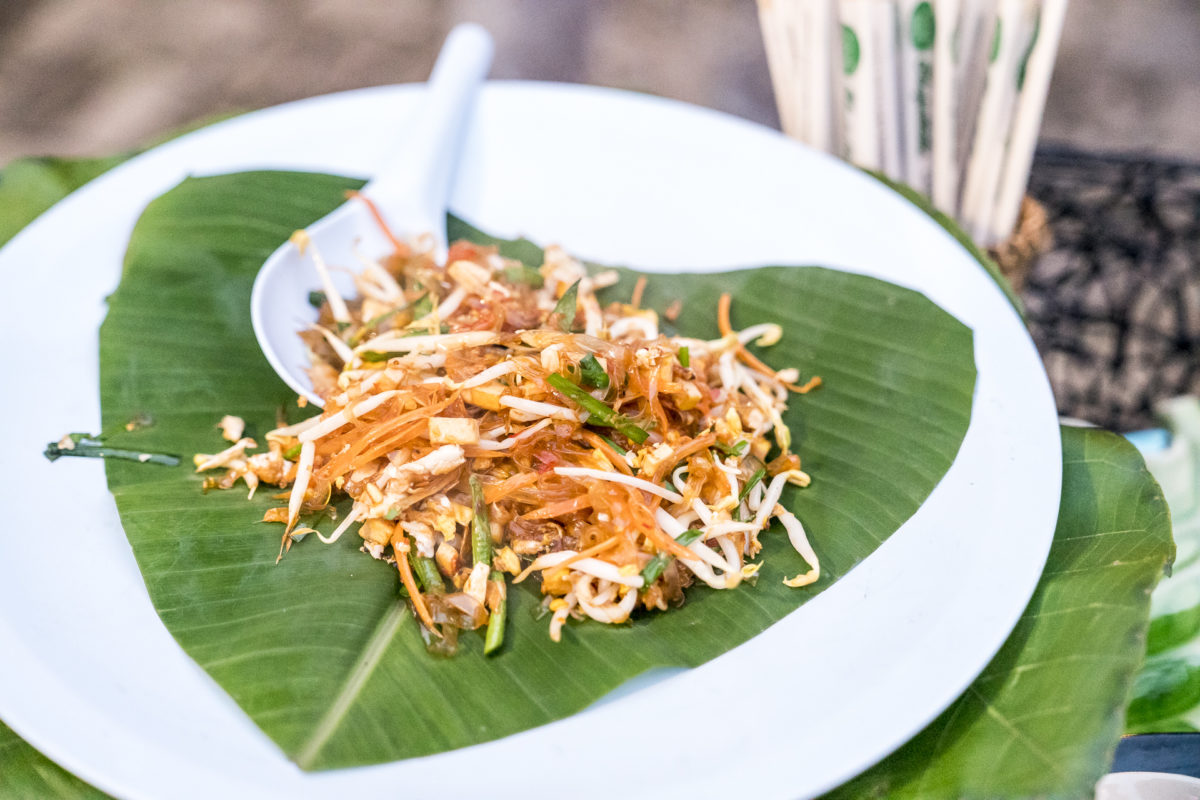
For those who appreciate the exchange with the local population, I can recommend the “farm to table” experience with a tour of the agricultural areas and subsequent cooking together. Farmer Toi, who showed us the fields, is planning to set up a “farmstay” in the near future.
Nordthailand off the beaten path: Lamphun & Lampang
While Chiang Rai and Chiang Mai are probably familiar to many and at least one of the two cities is integrated into many Thailand round trips, significantly fewer foreign guests visit the provinces of Lamphun and Lampang to the south. About a kilometer outside the city center of Lamphun, a stop at Wat Chamathewi is worthwhile. The Mahaphon Chedi there is one of the last architectural examples of the Dvaravati period.
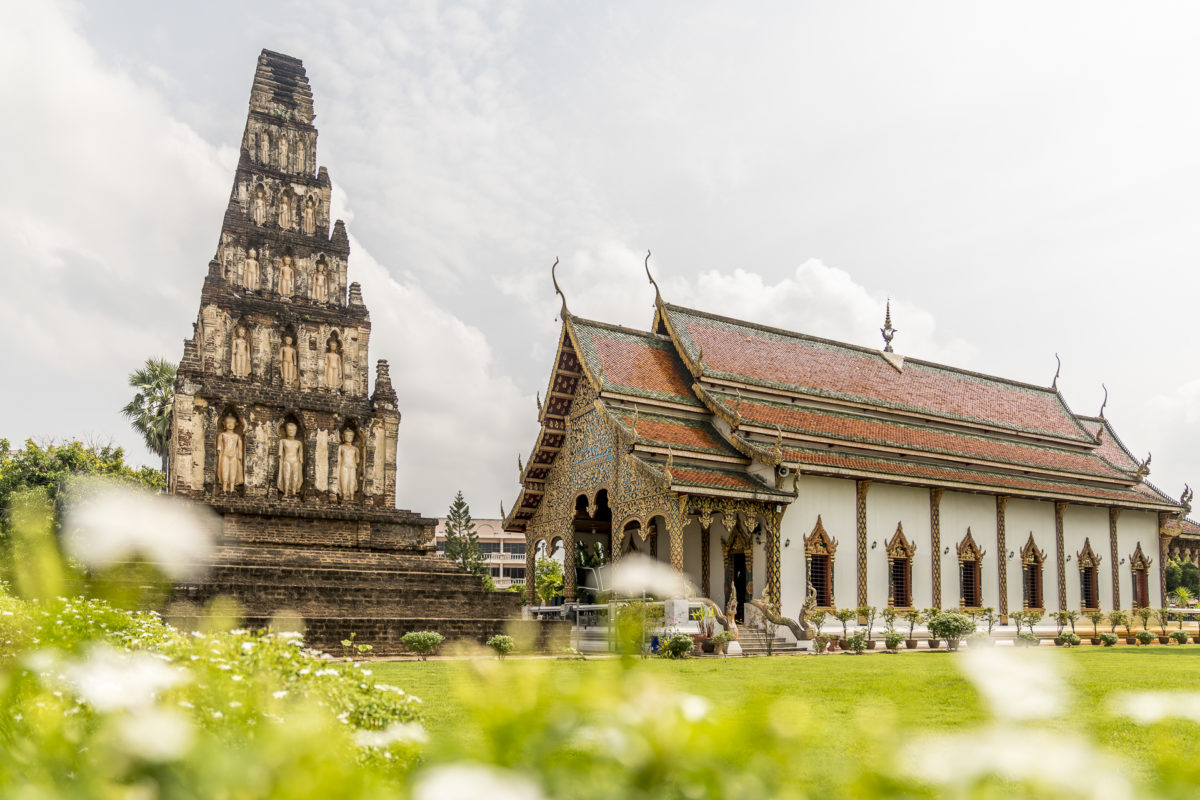
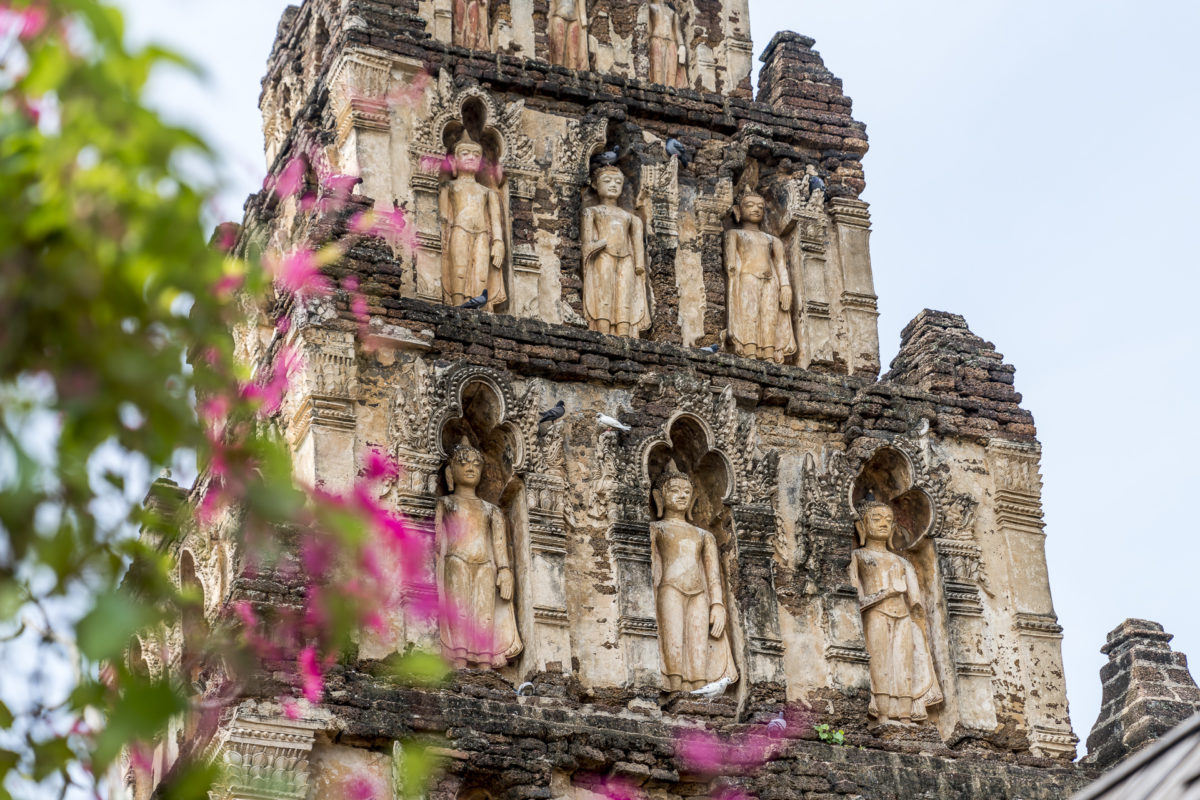
Between Wat Chamathewi and Wat Phra That Hariphunchai in the middle of the historic center of Lamphun we discovered a really authentic, nice café halfway – be sure to stop by Boran Cafe if you are in this area.
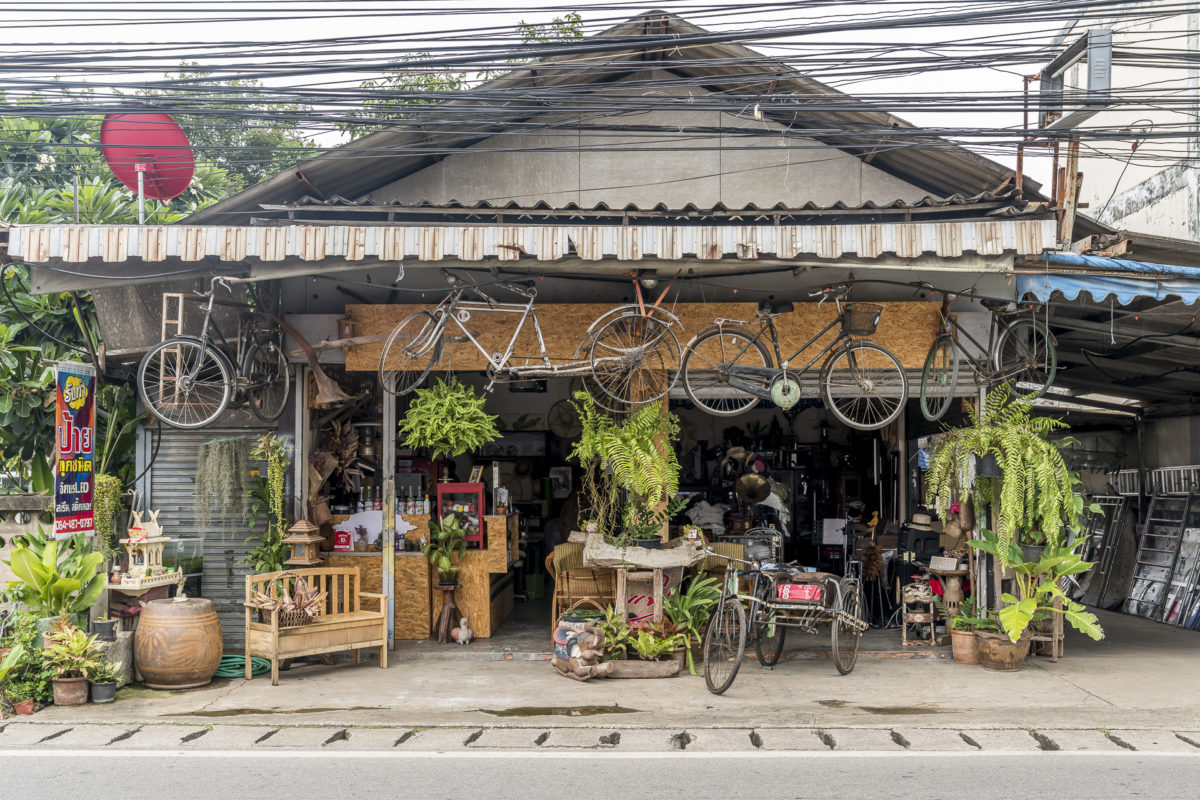
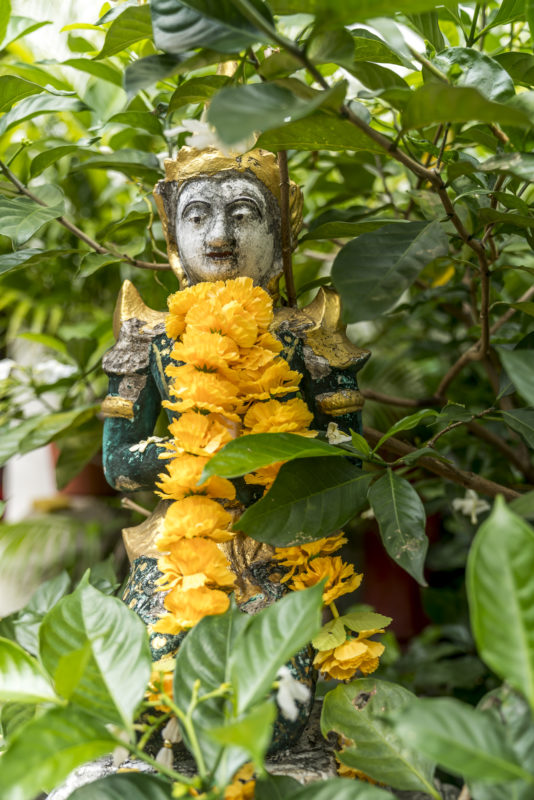
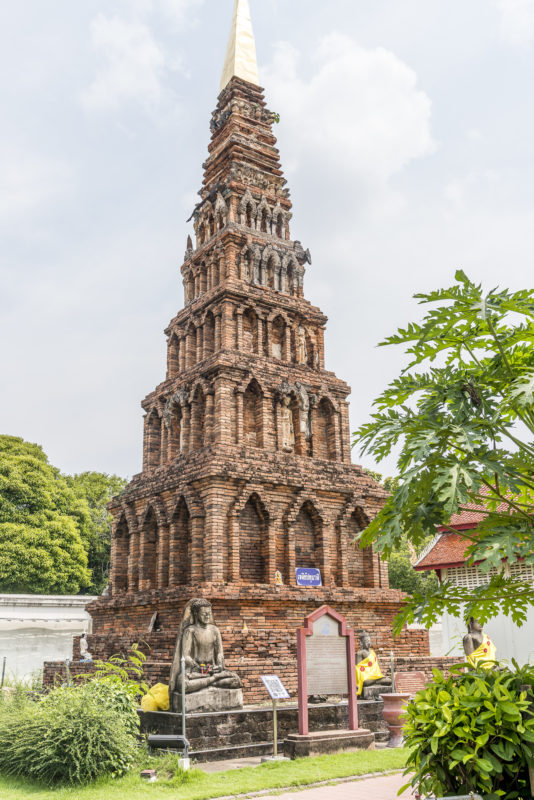
The visit to the old town of Lamphun and the temples takes about half a day. Afterward, we continue to Lampang. A gem can be found here in the district north of the Wang River. The local Wat Pong Sanuk Nua has been honored by UNESCO for its careful restoration. This is also one of the few temples in northern Thailand with a reclining Buddha.
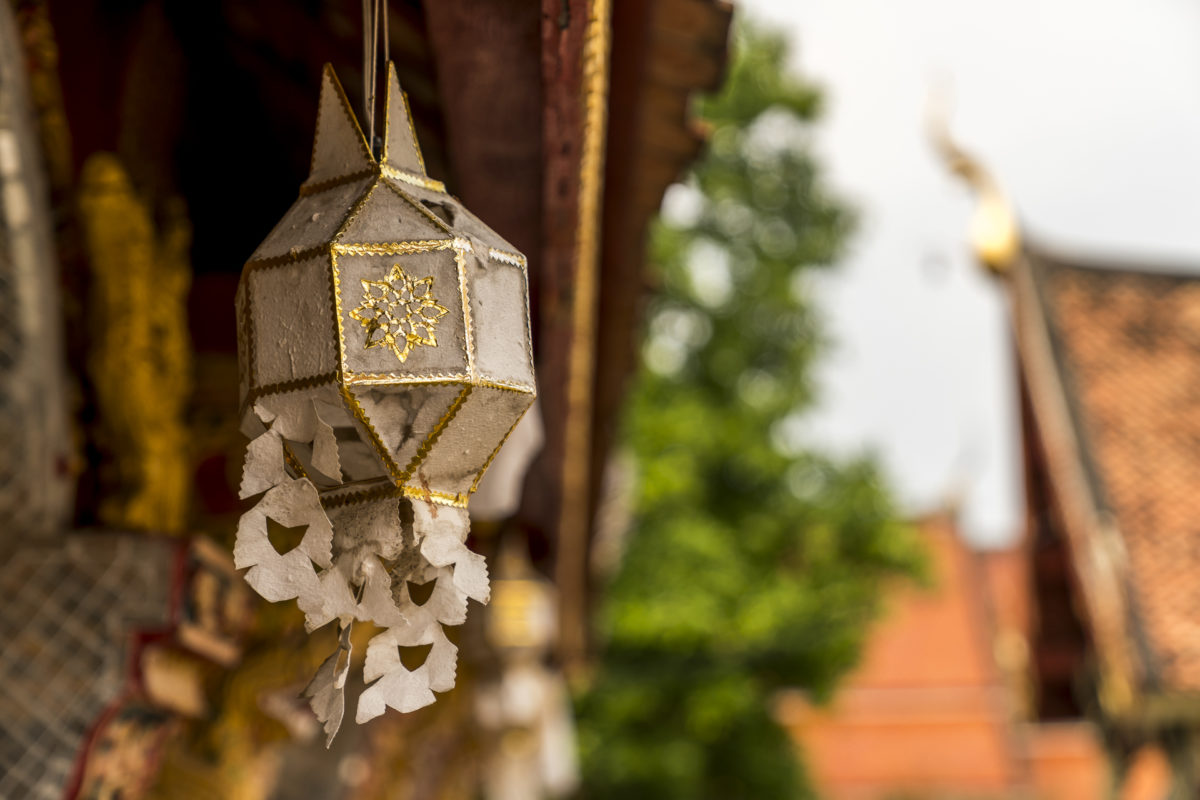
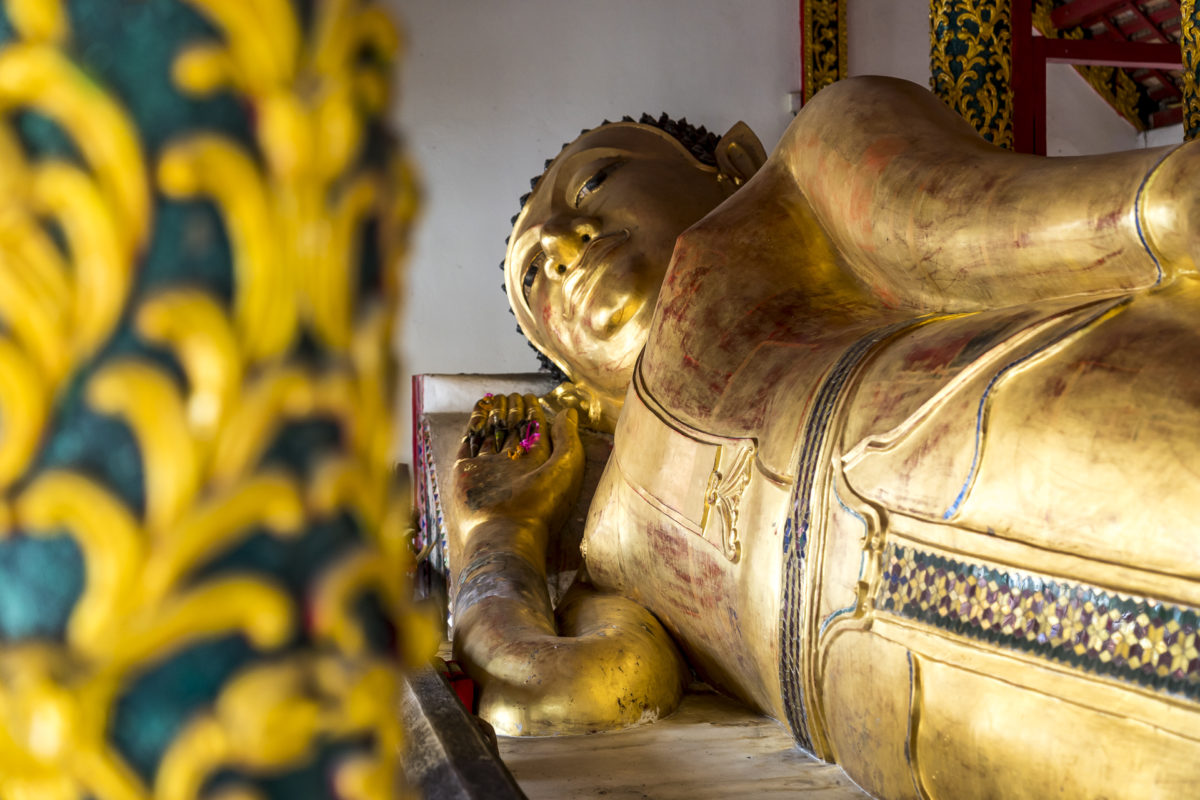
Also exciting is the visit to the Dhanabadee Ceramics Museum. The so-called “chicken bowls” from Lampang are the epitome of high-quality ceramic bowls throughout Thailand. In the factory shop next to the museum, in addition to the traditional range of products, there is also a lot of beautiful modern decorative material. If you are looking for a beautiful vase, then you could find it here.
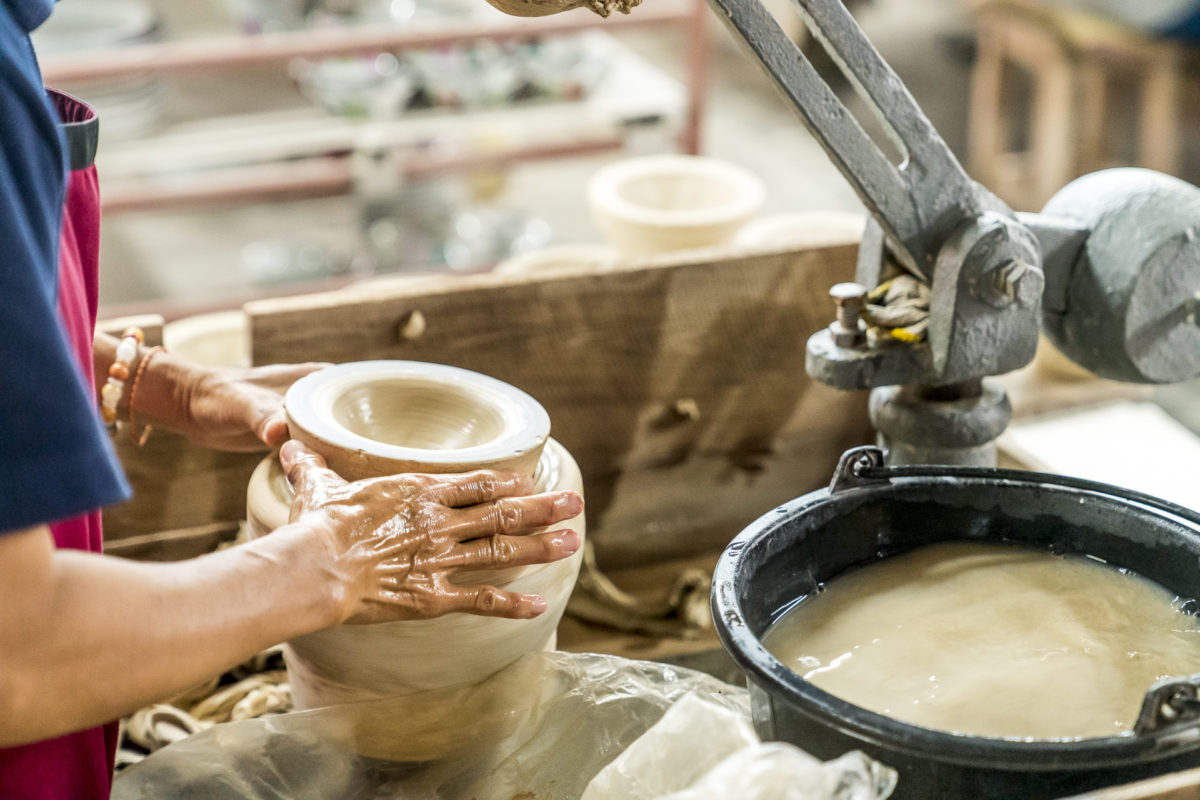
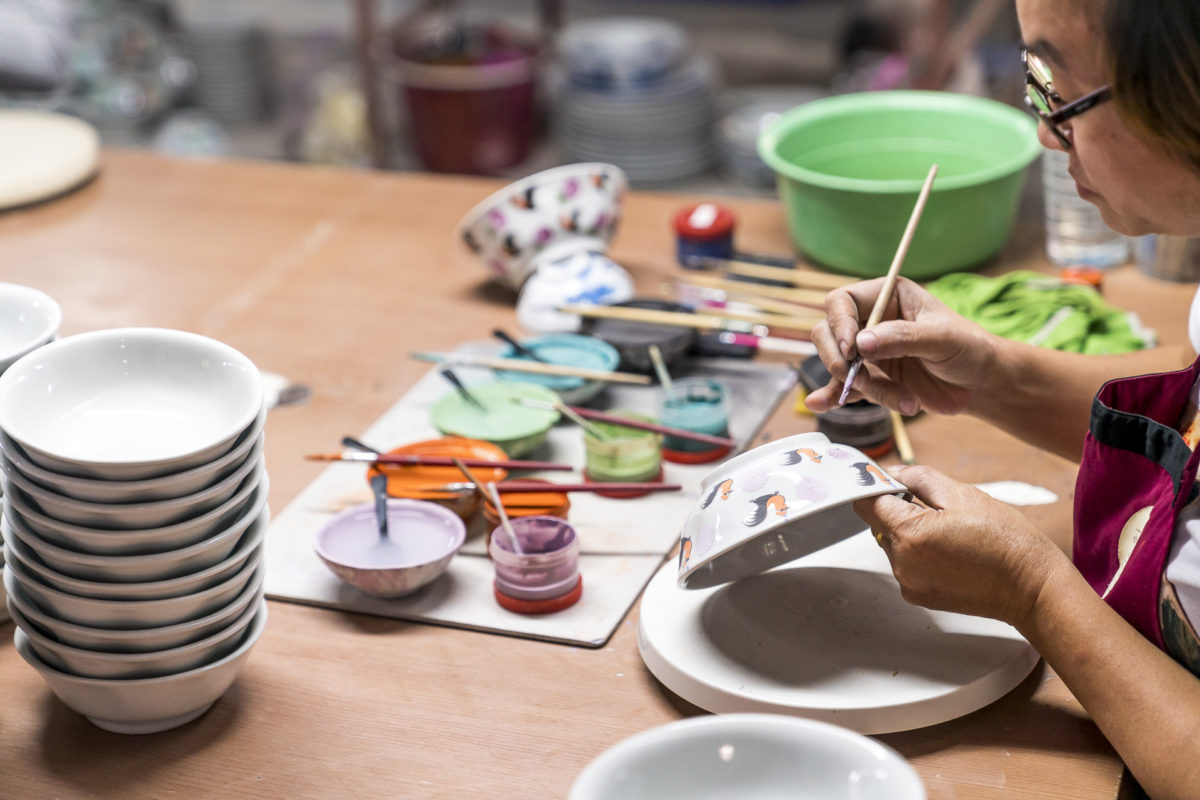
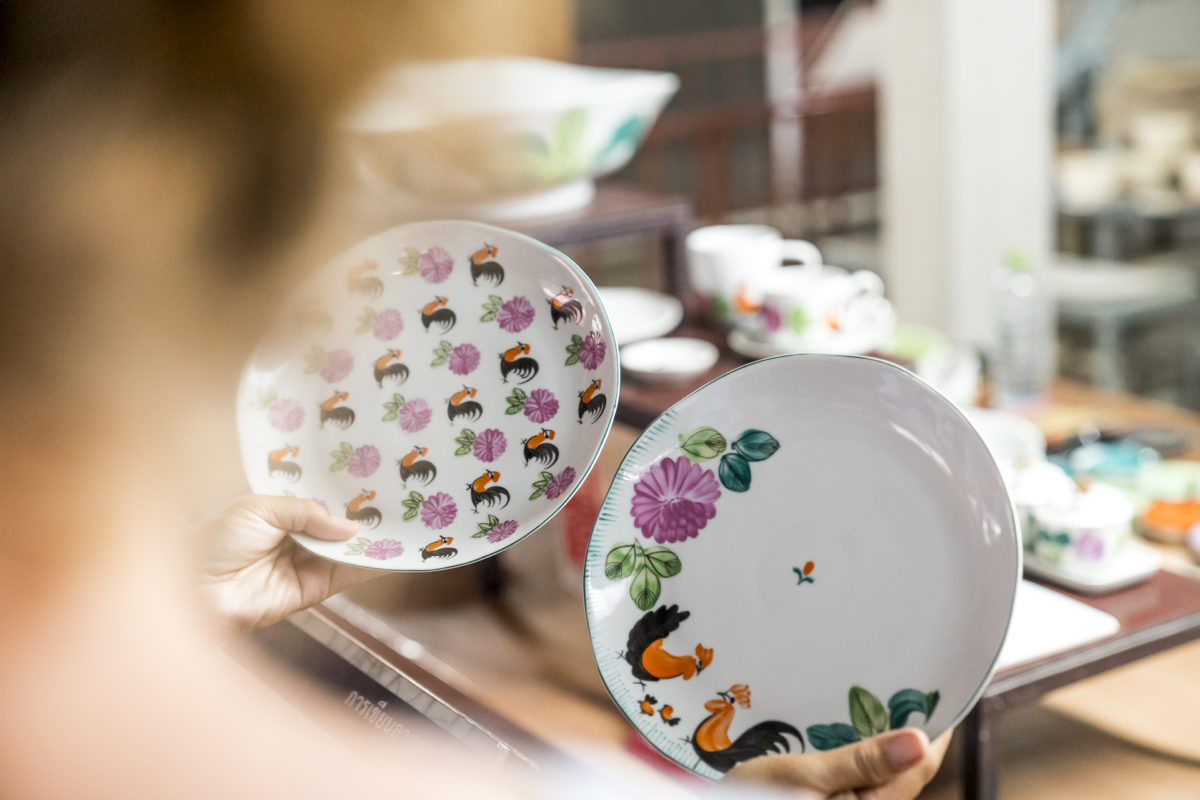
We spend the night in the secluded Lampang River Lodge. The standard of the wooden cottages is simple but charming and the complex is surrounded by lush greenery. The lodge is also conveniently located for visiting Wat Phrathat Lampang Luang, located southwest of the city.
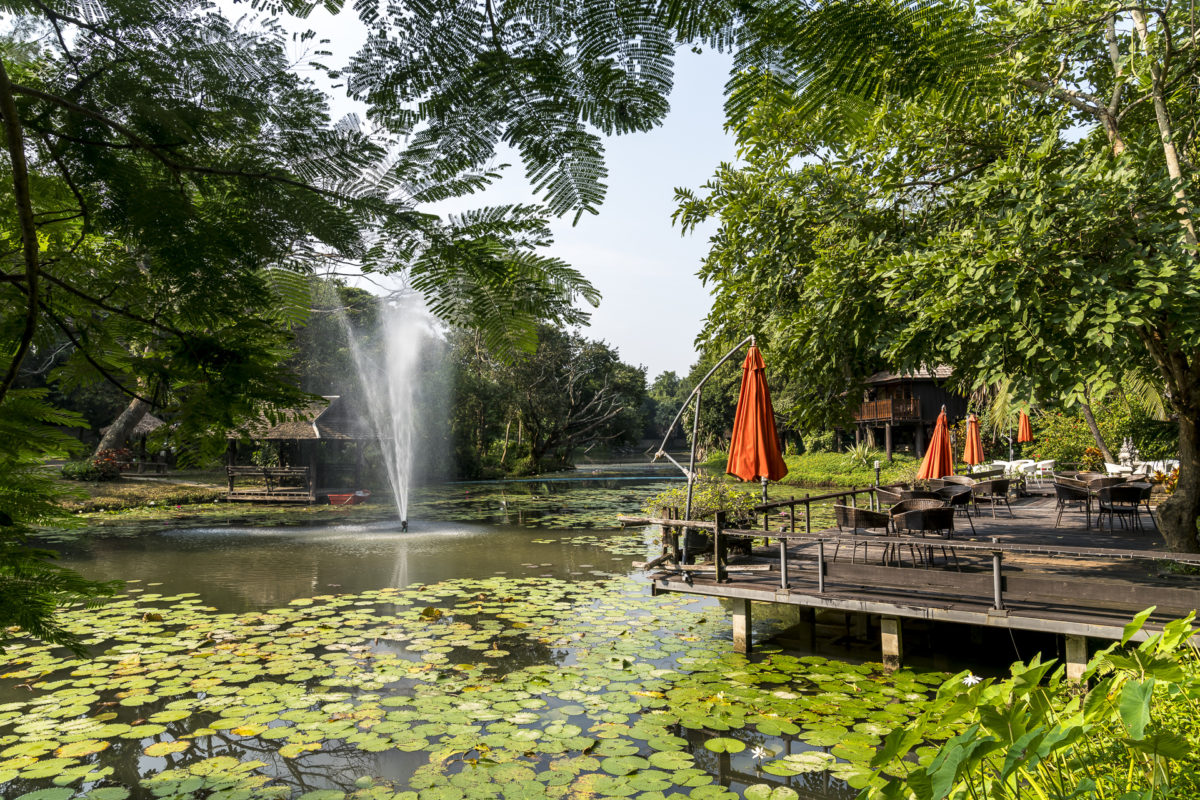
The temple is accessed via an imposing Naga staircase. Behind the delicately crafted main gate lies an extensive complex. By the time you have visited every single building and chedi, an hour or two is quickly over. If you then make your way towards Phrae/Sukhothai like we did, you will find a welcome refreshment in the “Home Cafe” on the left-hand side just before the intersection of the two main roads. We discovered the hidden backyard café thanks to a Google Maps location tag and were delighted by the cool – Korean-inspired – décor.
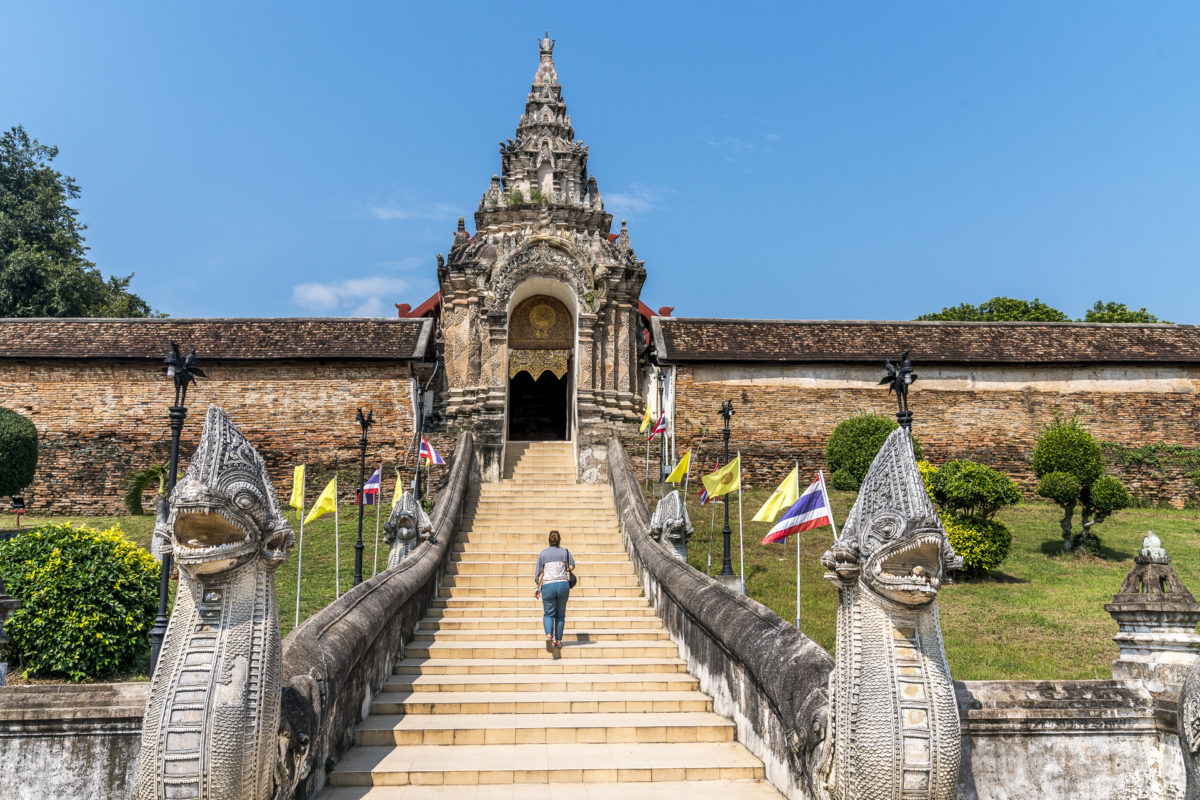
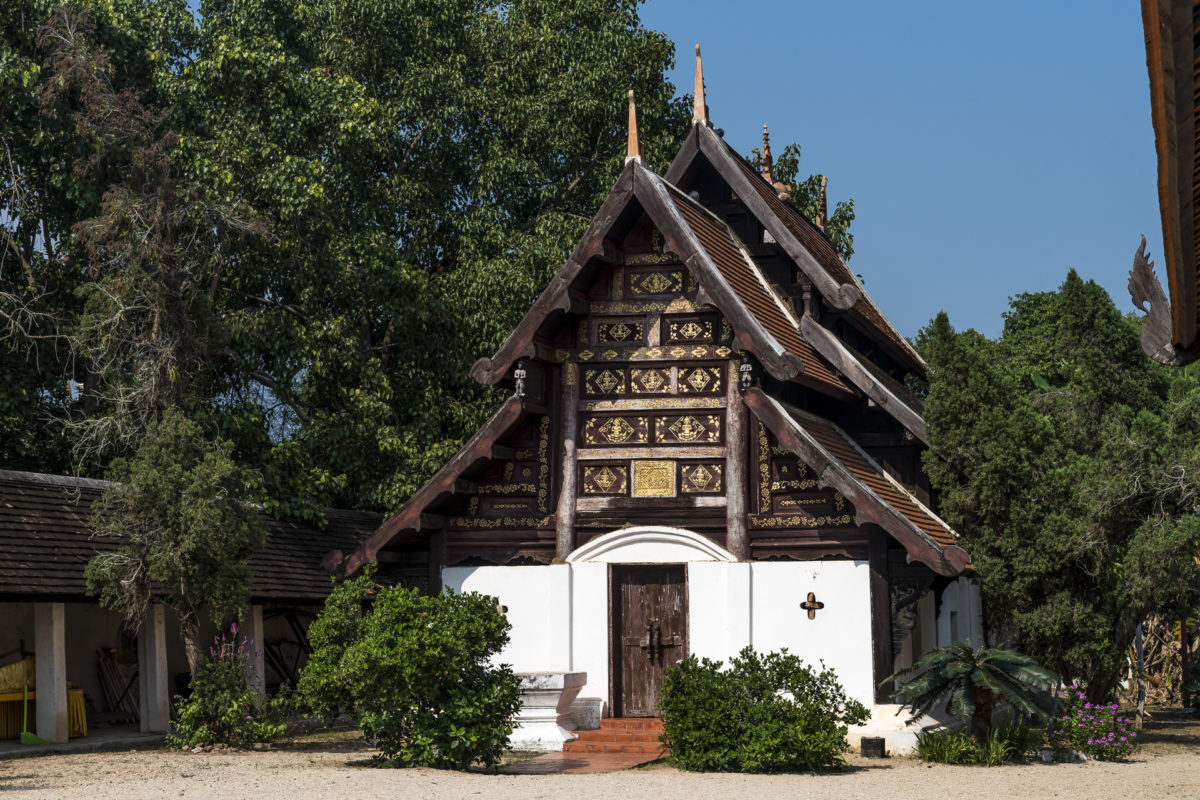
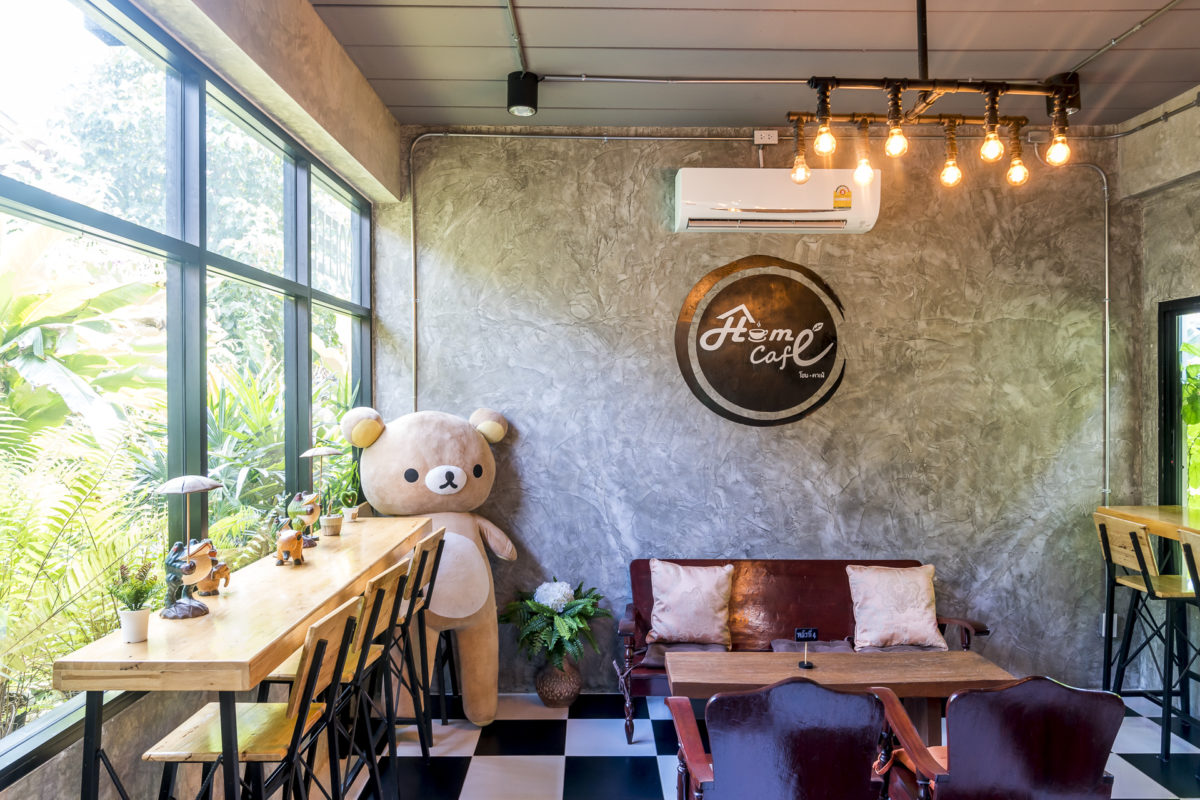
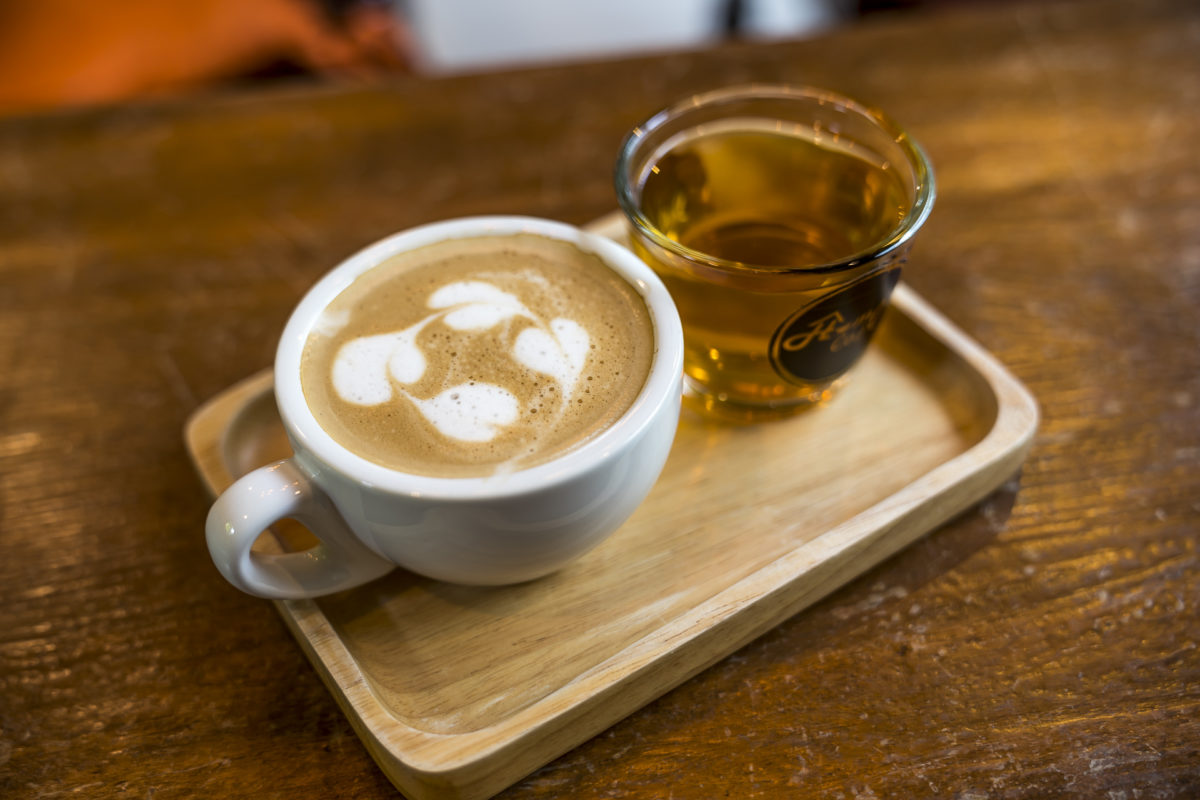
Staying with Thais: Homestay in Ban Na Ton Chan
Regardless of whether you fortify yourself in the café before your onward journey or jet off straight away – you should definitely plan another culinary stopover on the way to Sukhothai, namely in the inconspicuous Don Fai Restaurant, located directly on route no. 11. The restaurant is part of a shiitake growing area and serves the freshly harvested mushrooms with homemade rice noodles in the lampang chicken bowls. A little extra on the side: working Wi-Fi is also available here.
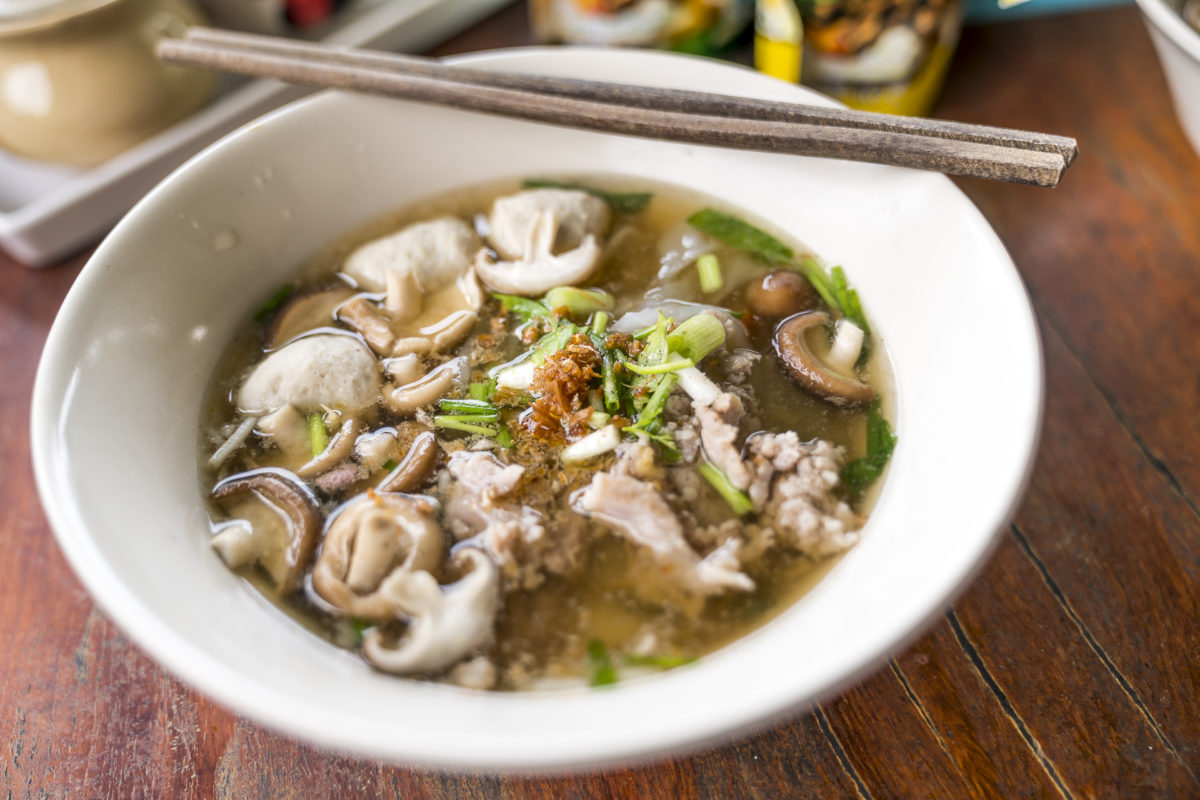
Shortly before road no. 101 meets road no. 102, we turn left into the hinterland. After about 20 minutes of driving, we arrive in Ban Na Ton Chan. Similar to Pang Ha, the majority of the villagers participate in community-based tourism. The initiative for this project came from Sangiam Sawaenklap, who joined forces with other women farmers in 1989 to sell home-made products. Later, workshops and homestays were added. Lately, the project has received several awards from various tourism organizations. What is certainly special is that the villagers offer their activities and accommodation on a jointly built platform – this means that they do not compete, but the homestays are rented out on a rotational basis so that everyone gets their turn.
Today, Pa-Pong welcomes us to her house, which is located right next to the community center, where the products made in the village (including so-called “mud cloth” fabrics) are sold and where there is also a nice café. The accommodation is simple but very nice. And the hospitality of Pa-Pong is unbeatable anyway. Later, we cycle through the village on rental bikes and hike through the rice fields together with Pa-Pong. Who knew that crayfish also feel at home in rice fields?
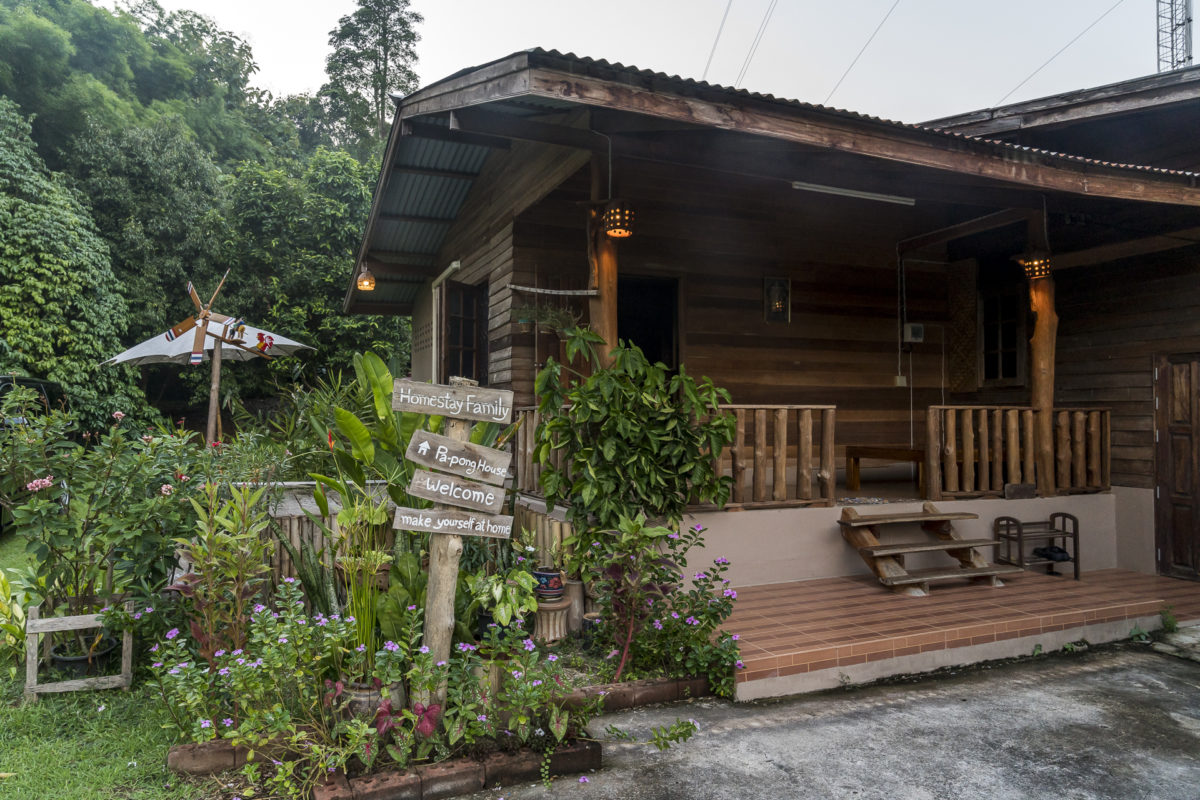
On-site activities include a sunrise hike up one of the surrounding green hills. We set off in the dark and reach the viewpoint just in time for the onset of dawn – definitely the most magical moment of these 9 days.
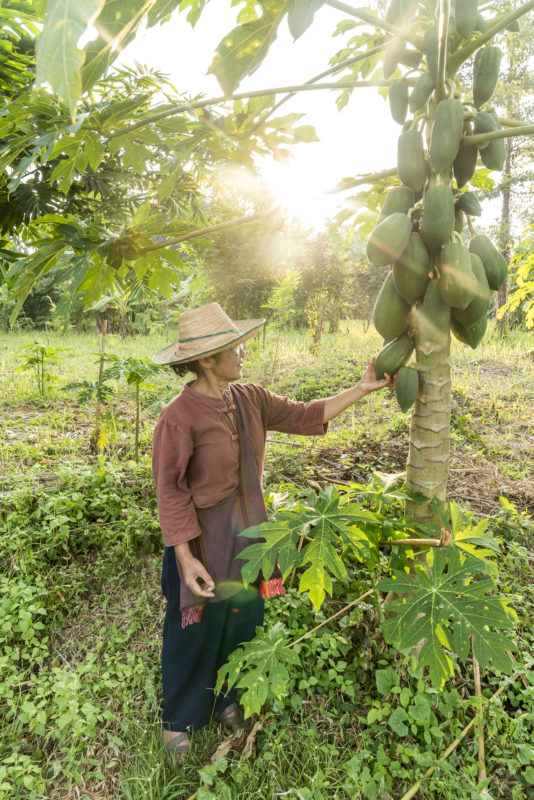
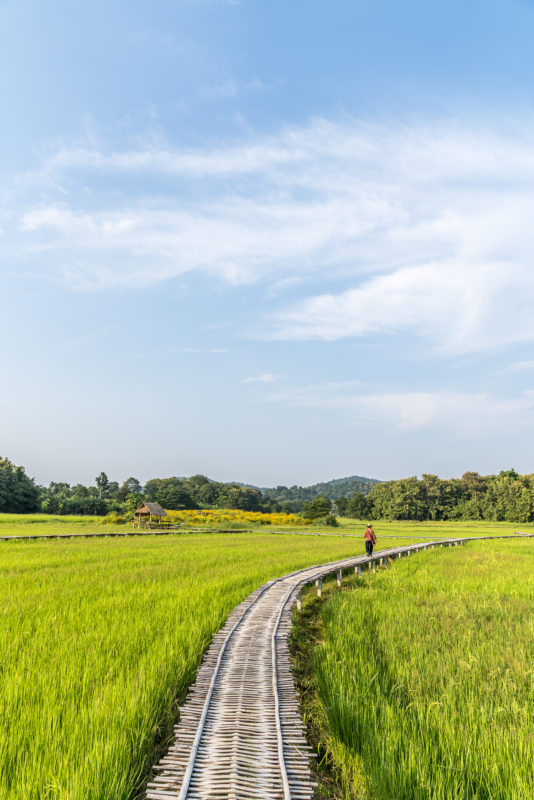
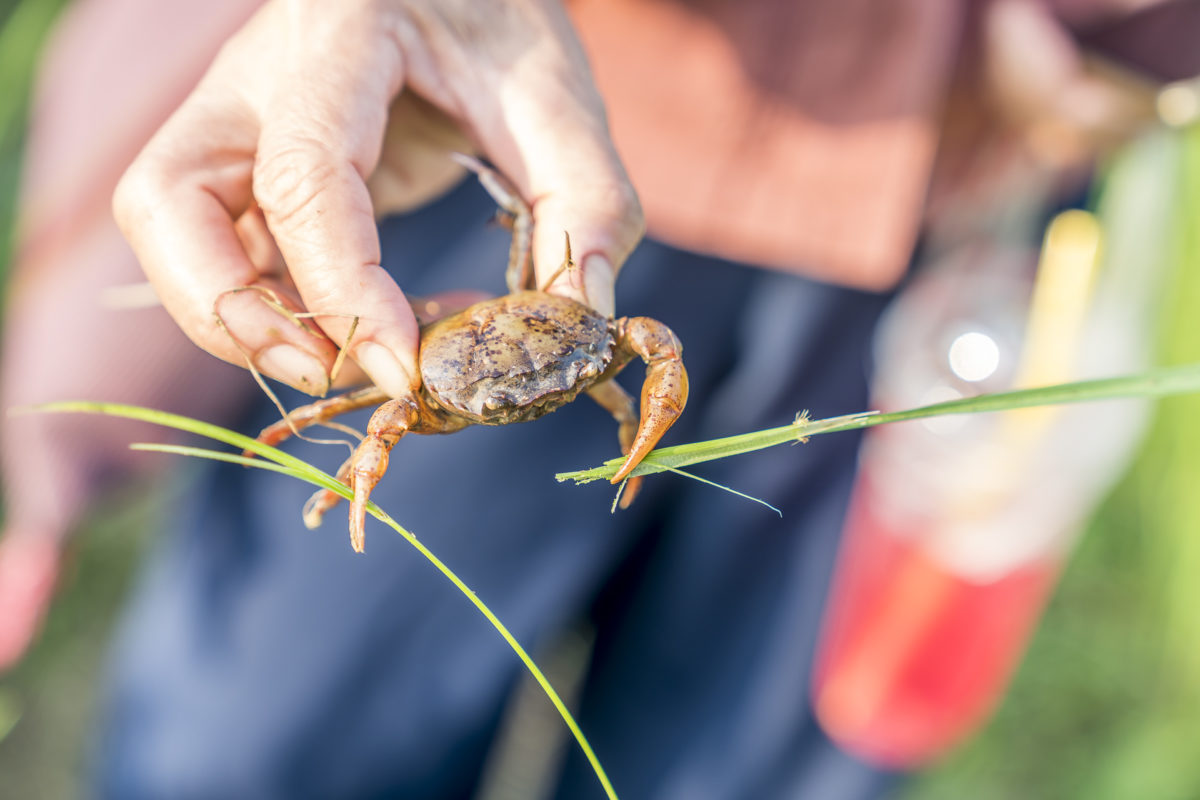
Back in the village, a hearty – and beautifully prepared breakfast awaits us. Pa-Pong had observed us photographing the food the day before and took this as an opportunity to prepare everything “picture perfect” for us. And that probably says enough about the passion with which the people participate in this village project. By the way, the few other guests we met on site were all Thais.
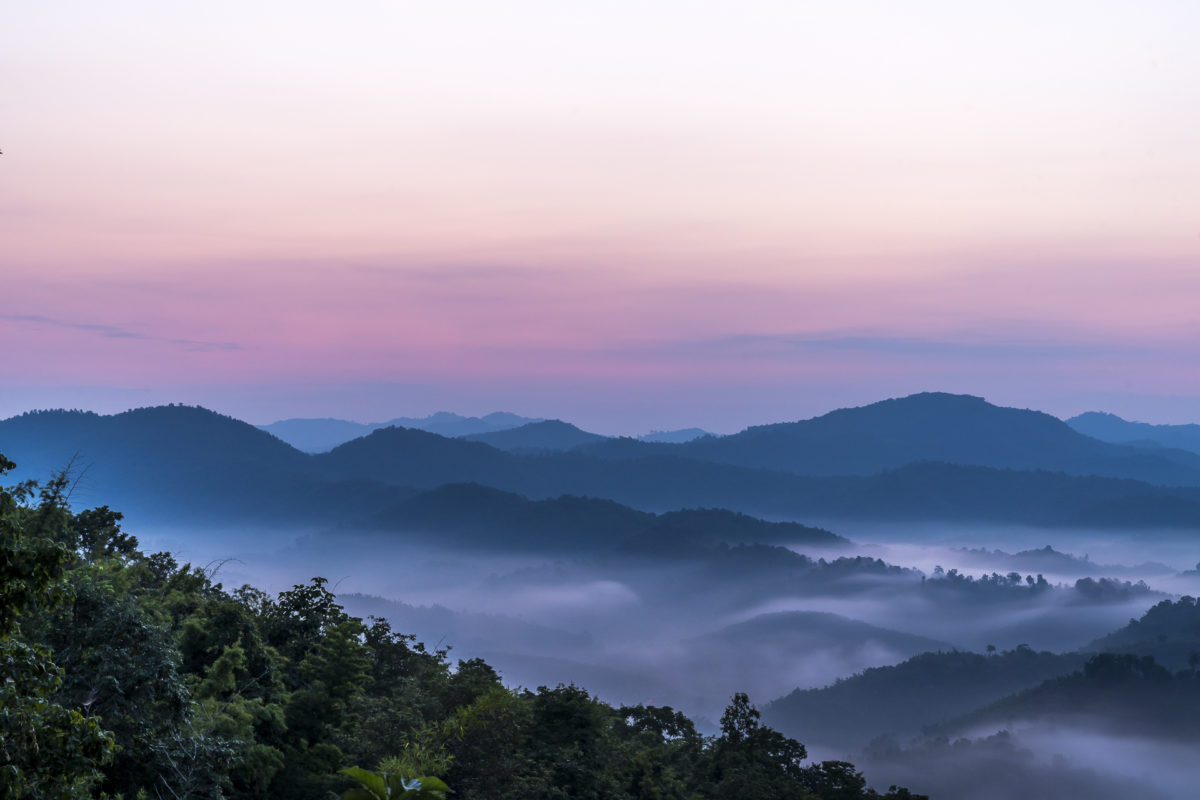
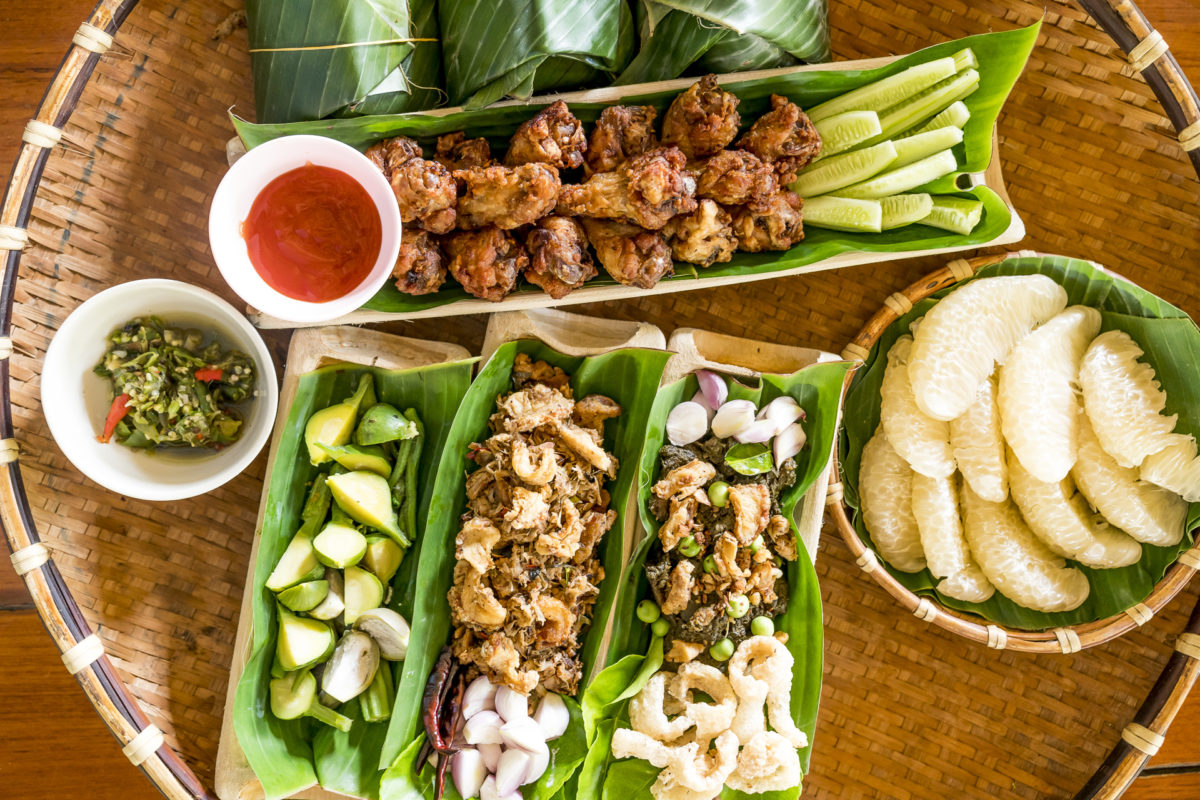
You can find more information about the village, the activities on site and the homestays on this page: homestaynatonchan.blogspot.com (information in English and Thai). An overnight stay in one of the homestays in Ba Na Ton Chan costs between 700–1,100 Baht including half board and bike rental (around 25–35 CHF).
Bike tour of Sri Satchanalai Historical Park
From Ban Na Ton Chan it is not far to the first historical site of the former kingdom of Sukhothai. The Si Satchanalai historical Parc is classified as a UNESCO World Heritage Site together with the Kamphaeng Phet historical Parc and the Sukhothai historical park. In all these parks you can visit the ruins of important cities at the time of the Sukhothai Kingdom (13th to 15th centuries). Since the parks are relatively extensive, it is worthwhile to rent a bike in the entrance area (costs bike rental around 30 Baht/park entrance fee 100 Baht) and go on an exploration tour with it. I really liked this facility – also in comparison to the one in Sukhothai. This may be because it is very original and there was virtually nothing going on site. Apart from us, there was only one group of students who spent their free afternoon here.
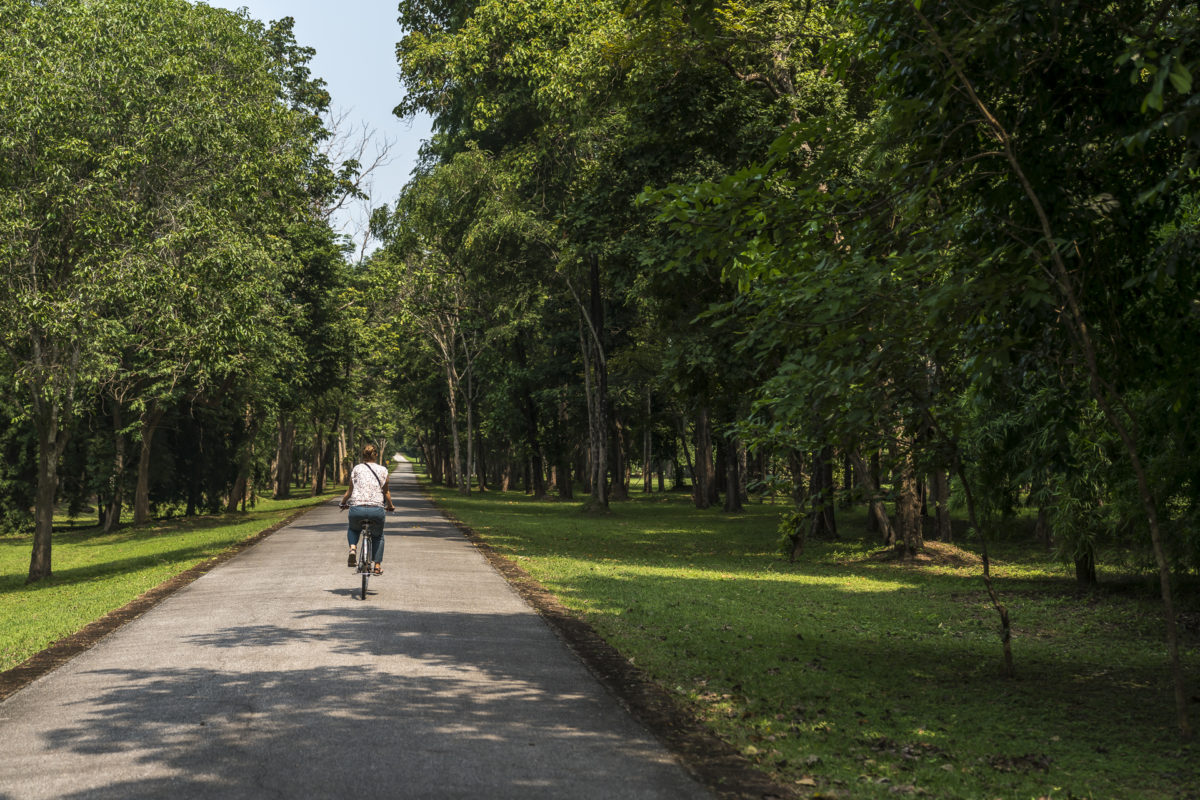
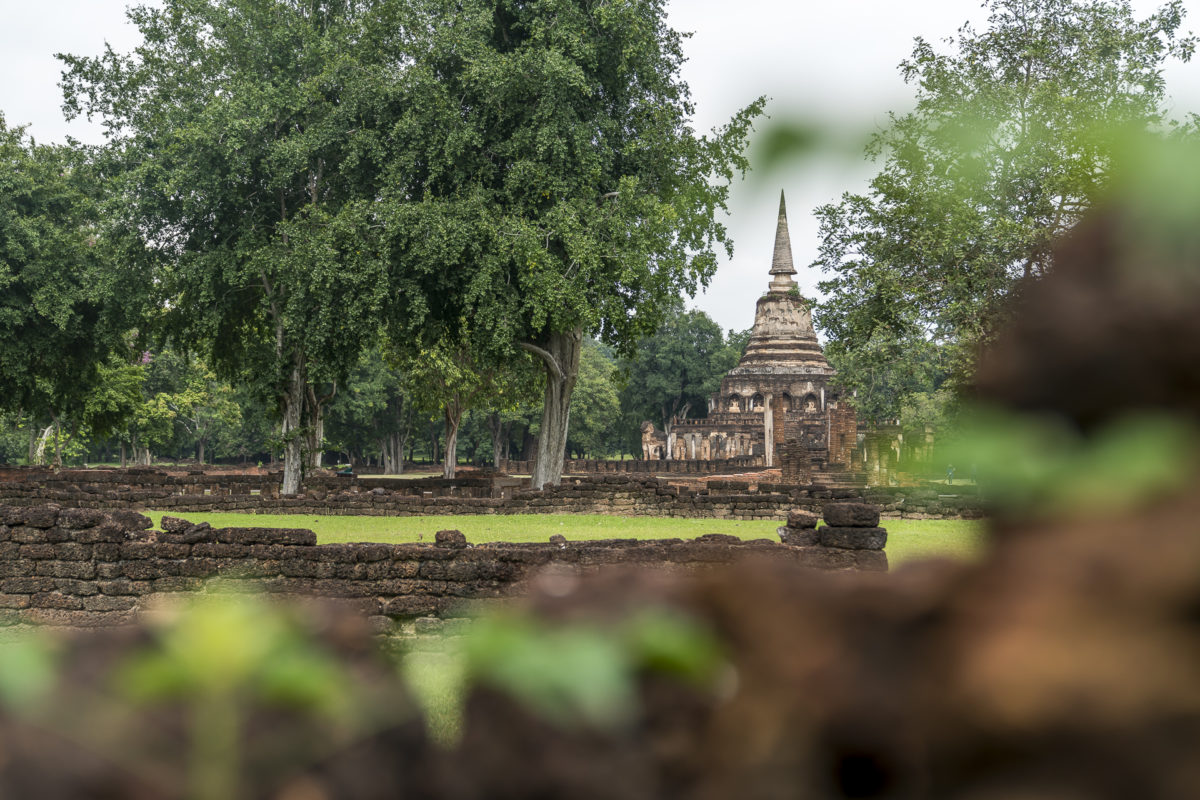
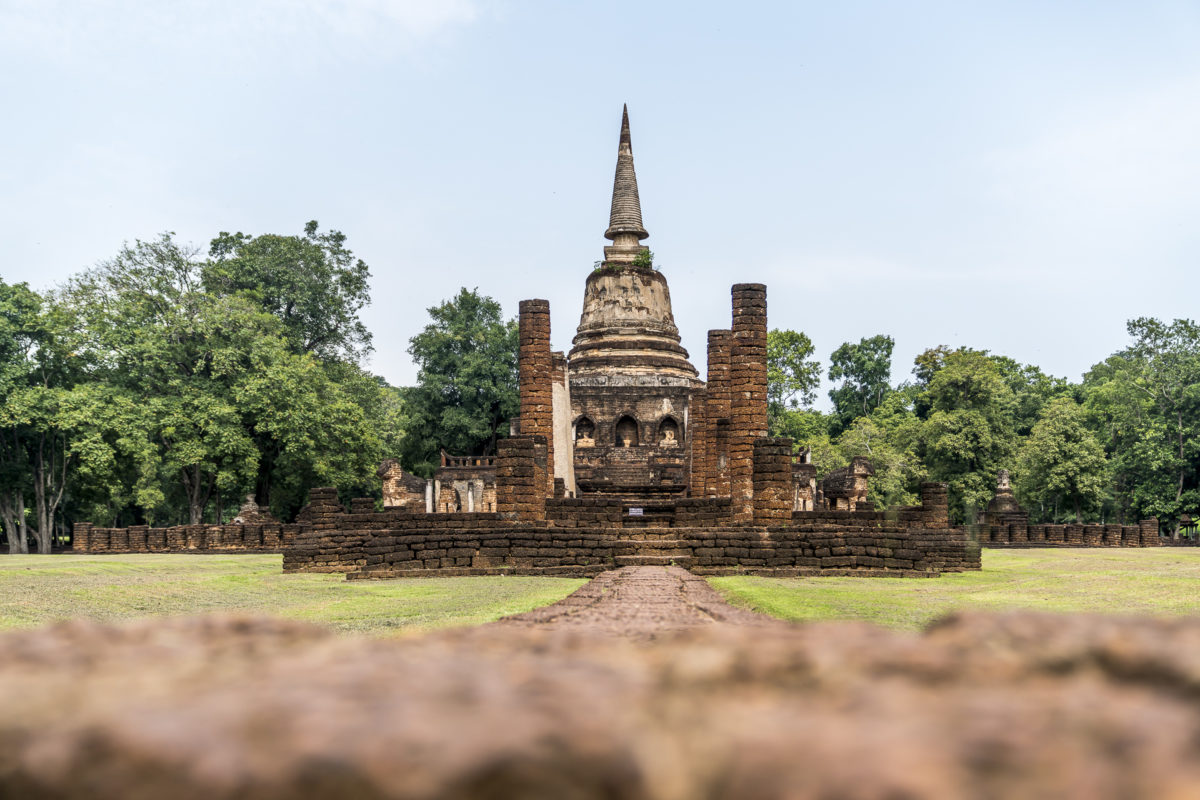
Sukhothai – the old royal city as the crowning glory
In Sukhothai, too, there are various opportunities to creatively engage with traditional crafts. By cultivating the unique local culture in handicraft products, traditional textiles, Sukhothai was included in the list of “Creative Cities” at the end of 2019. With this award, UNESCO honors destinations that actively integrate and promote creativity in urban development. One who likes to pass on his knowledge is the Amulet Maker Kob. He is in 8. Generation is active in the production of so-called votive tablets (Buddhist amulets) and offers an insight into this traditional craft in workshops.
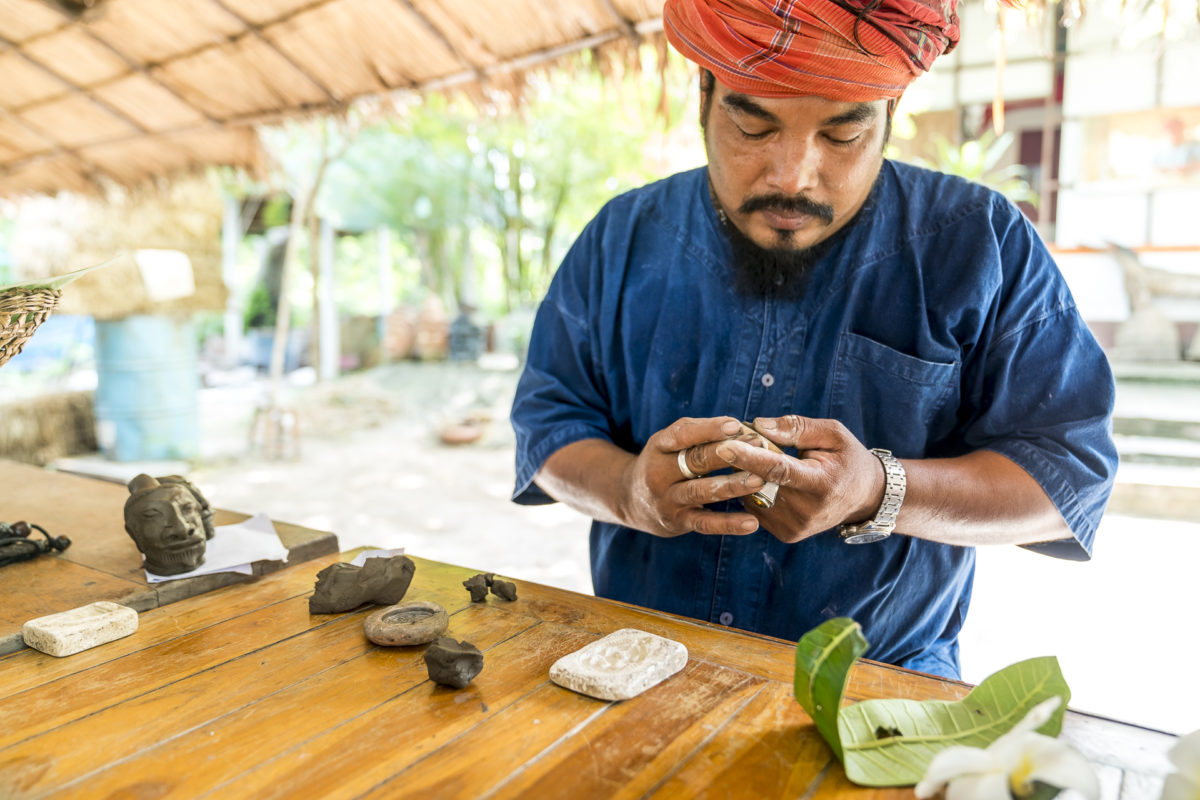
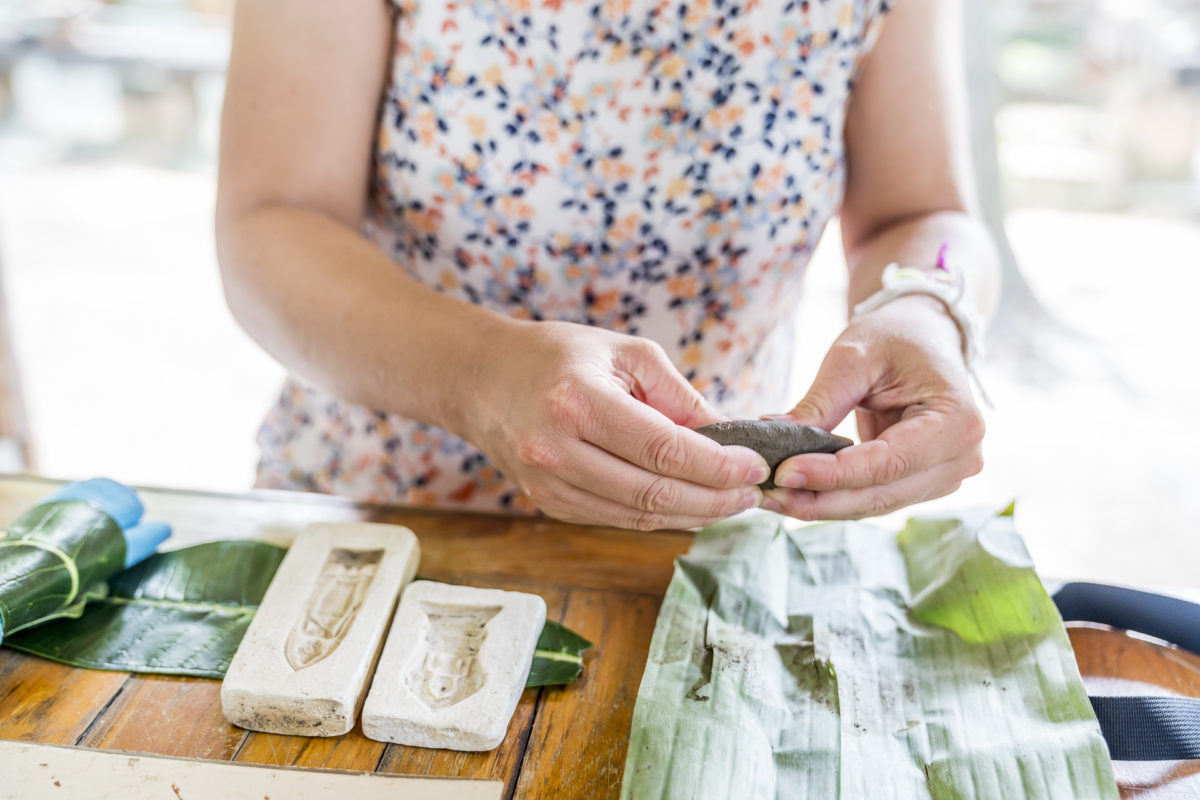
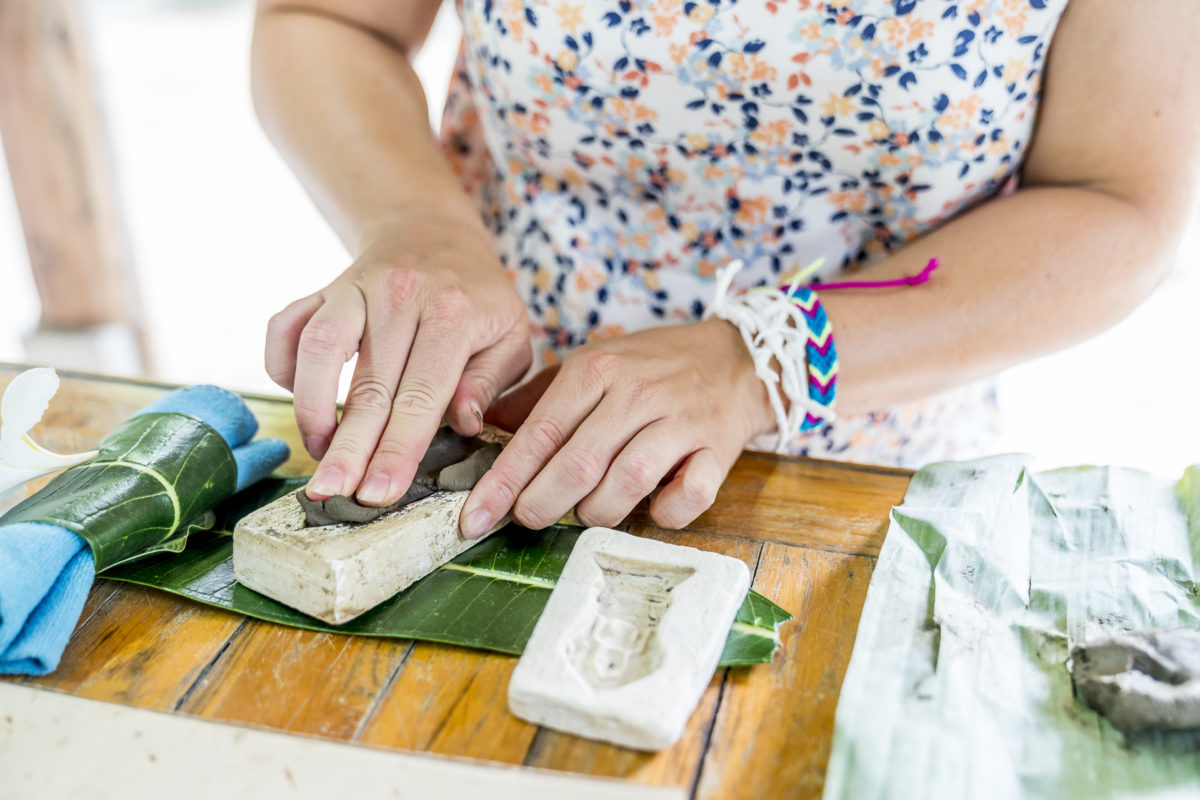
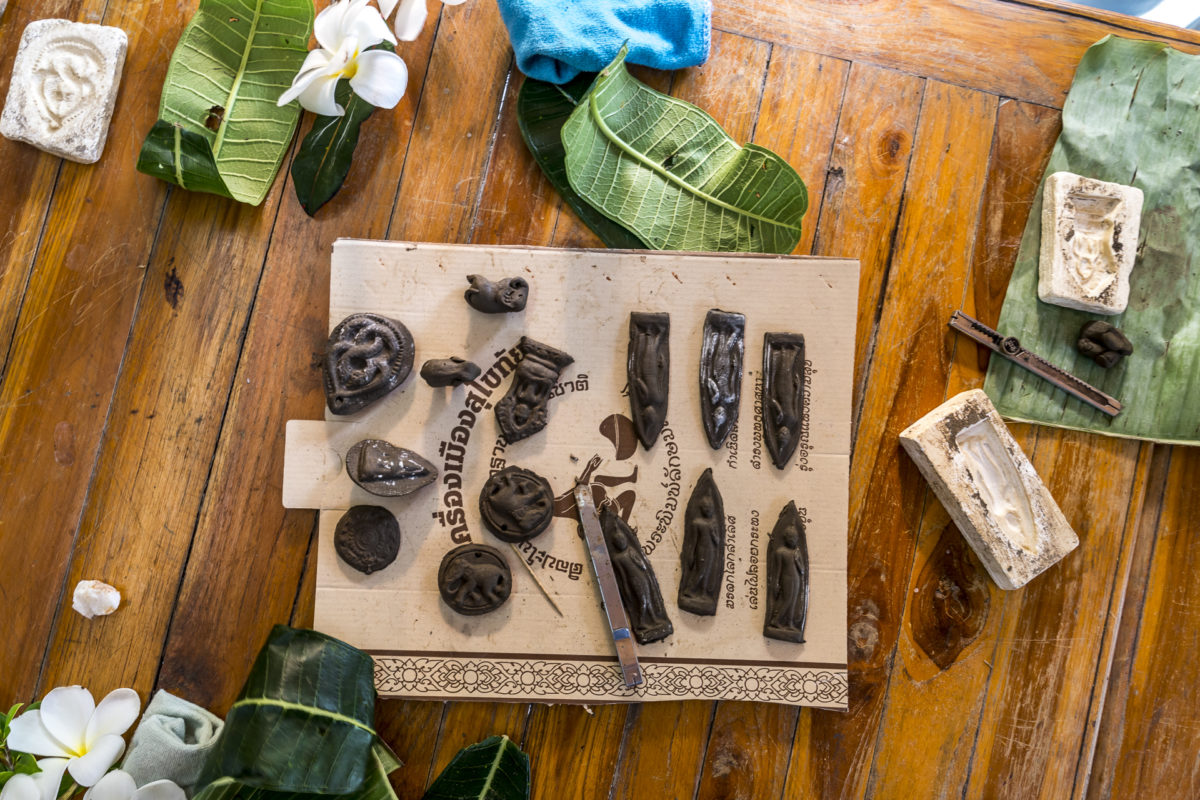
With a homemade amulet as a souvenir, we get back on our bikes shortly before sunset. In Sukhothai the bike rental is 20 Baht more expensive than in Satchanalai, but the sky gives us a wonderful atmosphere at the end of this trip. On the last evening, we enjoy fine street food at the night market south of Wat Sa Si (right on the edge of the Historical Parc). There are not only food stalls here, but also traditional seating. A fitting end to a fascinating journey through northern Thailand.
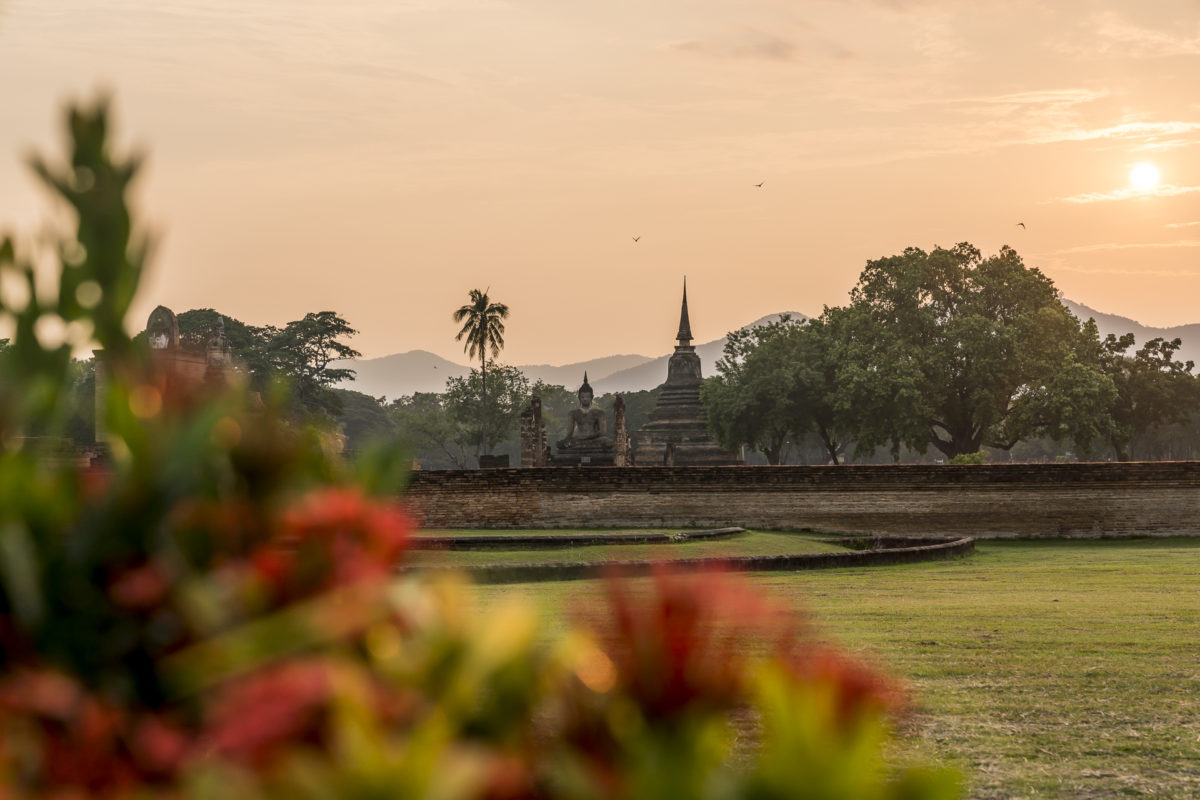
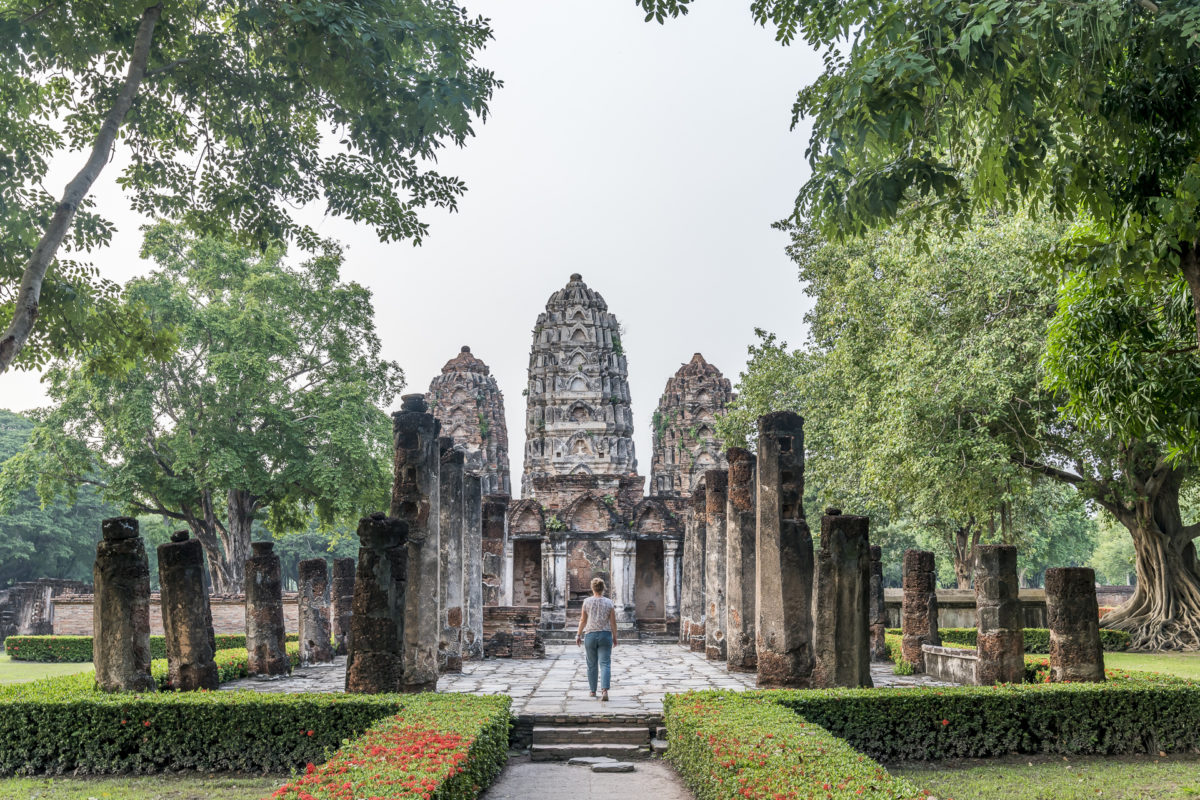
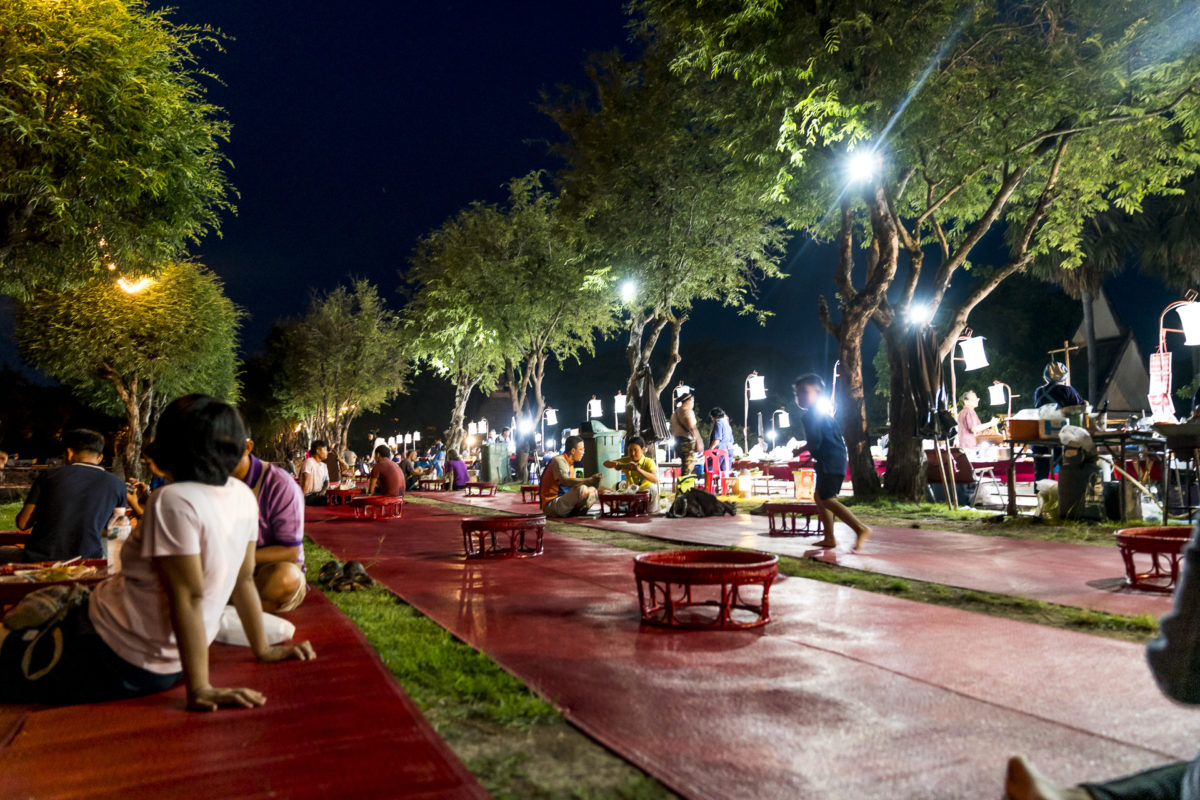
Practical tips for your trip through northern Thailand
The peak season is from November to February. Then it is mostly sunny and pleasantly warm in northern Thailand. From March to May, the temperatures rise continuously – the warm and humid heat period with temperatures of up to 40° is followed by the rainy season from June to October. We were in northern Thailand at the end of September – during the rainy season – and had great weather throughout. If you want to avoid the main season in the winter months, I can highly recommend the end of the rainy season.
Swiss nationals need a passport valid for the duration of their stay to enter Thailand. No visa is required for stays of less than 30 days.
There are direct flights from Zurich to Bangkok several times a day. We flew with Thai Airways via Bangkok to Chiang Rai. Alternatively, there are train connections from Bangkok to Lamphun and Chiang Mai (journey time around 11 hours).
The Thai currency is called Baht (BHT). 100 baht is equivalent to around 3.20 CHF.
In the tourist hotspots, you can communicate in English. When in contact with the local population and also when visiting villages/homestays, it is helpful if you know a few words of Thai or have a guide with you to help you translate.
When entering a temple building, shoes must be removed and the upper arms and legs must be covered (no tops, sleeveless shirts or shorts/hot pants). In addition, you should make sure that you do not point your feet at Buddha statues or at other people (feet are considered unclean).
Photography is usually allowed in the temple complexes: in some temple buildings only men have access (was the case with 2 specific temple buildings on our trip).
If you look something on Google during your stay in Thailand, you will notice that entirely different dates are spit out. This is due to the Buddhist calendar, which is not aligned with the Gregorian calendar. The year 2020 corresponds to the year 2563.
Note: this trip was at the invitation of Amazing Thailand: thank you very much for this! All impressions and opinions are, as always, ours.


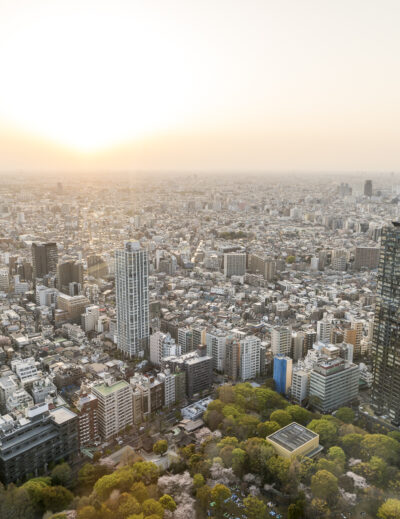


Leave a Reply